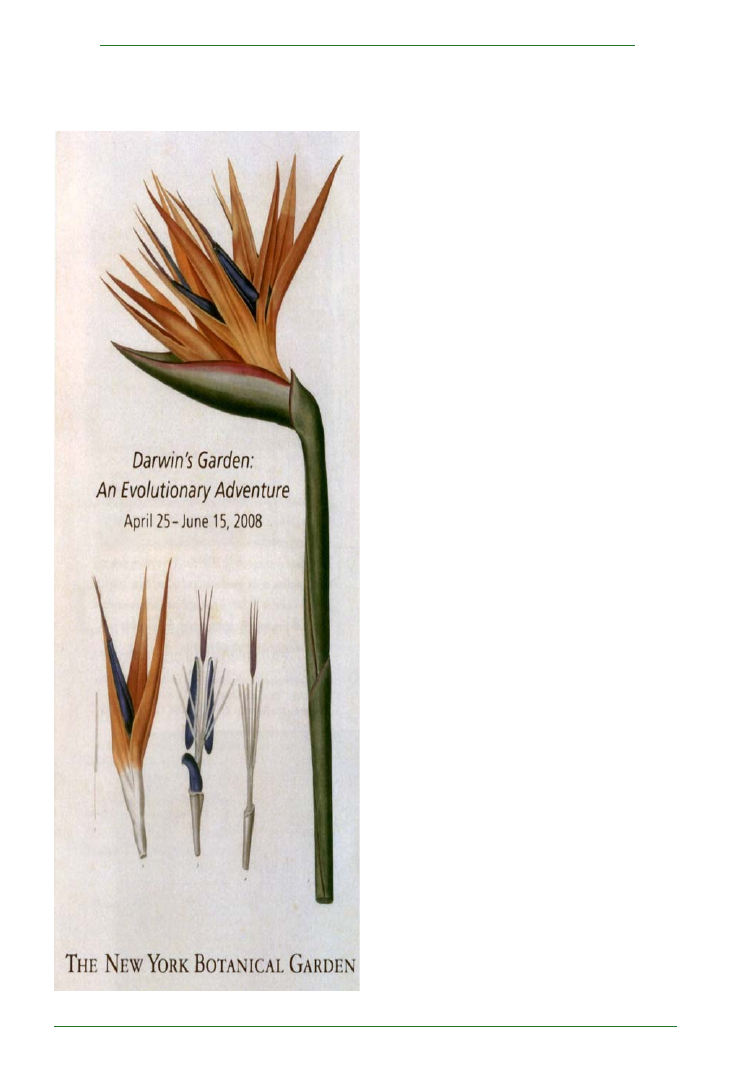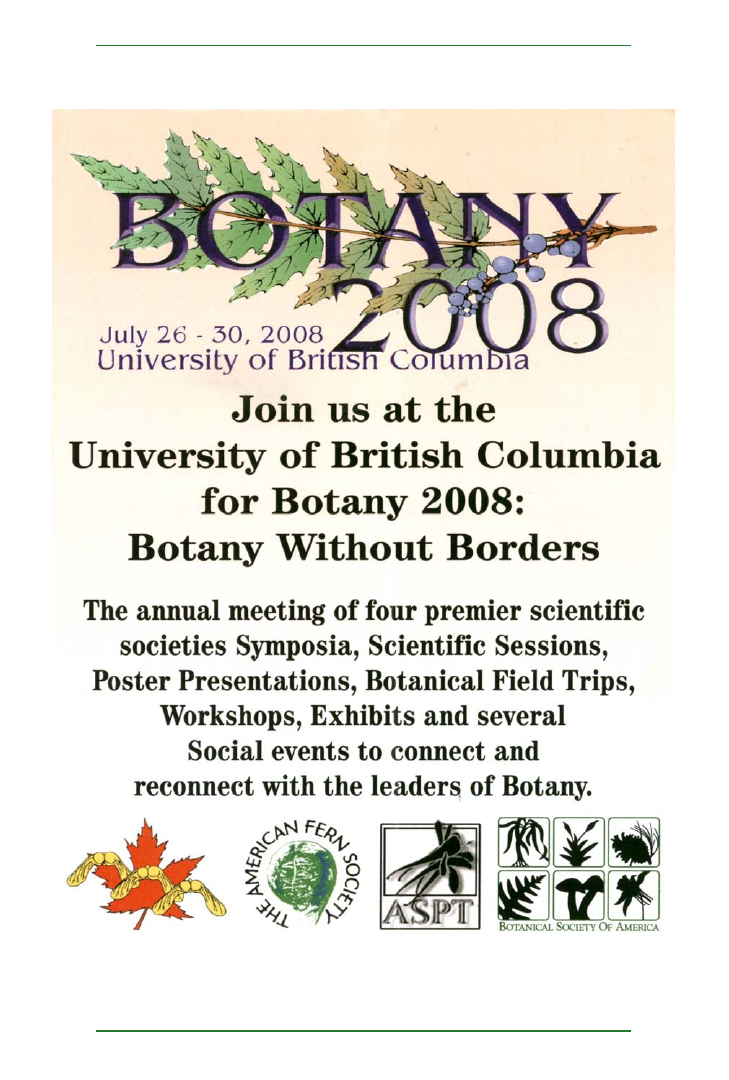
BULLETIN
SUMMER 2008 VOLUME 54
NUMBER 2
2@2
PLANT SCIENCE
ISSN 0032-0919
The Botanical Society of America: The Society for ALL Plant Biologists
THE BOTANICAL SOCIETY OF AMERICA
Leading Scientists
and
Educators
since 1893
The Students Were Right All Along...Plants Really Are B.O.R.I.N.G................................50
Symposia in Plant Neurobiology: A New Venue for Discussion of Plant Behavior and
Communication..........................................................................................................................56
News from the Society
News from the Office................................................................................................58
BSA Award Recipients...........................................................................................59
BSA Education News and Notes...........................................................................60
Editor’s Choice..........................................................................................................61
News from the Sections
Emanual D. Rudolph Award - Historical Section..................................................62
Announcements
In Memoriam
Jerry McClure 1939-2006..........................................................................62
James Edward Canright (1920-2008)......................................................63
Personalia
Peter Raven Elected to National Geographic Board of Trustees......65
Peter Raven wins BBVA Foundation Award for Conservation
Biology.......................................................................................66
Positions Available
Director, Boyce Thompson Southwestern Arboretum.......................66
Teaching Postdoctoral Position, University of Oklahoma.................67
Postdoctoral Research Fellowship in Ecological Genomics..............67
Symposia, Conferences, Meetings
New Phytologist Symposia for 2008......................................................68
Janet Meakin Poor Research Symposium Explores Climate Change.68
IV Latin American and Caribbean Congress of Cacti and other
Succulents.................................................................................69
Award Opportunities
Grants for Ornamental Horticulture........................................................69
Other News
Lenhardt Library Exhibit Tells Story of Priceless Rare Book.............69
Three Big Horticultural Honors for the Missouri Botanical Garden.70
Darwin’s Garden: An Evolutionary Adventure...................................71
New England Wild Flower Society’s Garden in the Woods..............74
Priming Scientists for Successful Media Interviews...........................74
‘Parasite Lost’: Botanists Discovers Unusual Plant Missing
since 1985...................................................................................74
Book Reviews...........................................................................................................................77
Books Received........................................................................................................................82
Botany 2008...............................................................................................................................84

5 0
Plant Science Bulletin 54(2) 2008
P
LANT
S
CIENCE
B
ULLETIN
POSTMASTER: Send address changes to:
Botanical Society of America
Business Office
P.O. Box 299
St. Louis, MO 63166-0299
E-mail: bsa-manager@botany.org
Address Editorial Matters (only) to:
Marshall D. Sundberg, Editor
Dept. Biol. Sci., Emporia State Univ.
1200 Commercial St.
Emporia, KS 66801-5057
Phone 620-341-5605
E-mail: psb@botany.org
ISSN 0032-0919
Published quarterly by Botanical Society of America, Inc., 4475 Castleman Avenue, St. Louis,
MO 63166-0299. The yearly subscription rate of $15 is included in the membership dues of
the Botanical Society of America, Inc. Periodical postage paid at St. Louis, MO and additional
mailing office.
Are we part of the problem of declining student
interest in botany because we are making plants
BORING? One certainly can argue that traditional
instruction of traditional material does not help. The
two feature articles in this issue may provide some
ideas to help you infuse some excitement and
wonder into your botany courses. David Senchina
provides some tips that get right to the point of
raising student awareness of the relevance of botany
to their daily lives without necessarily making radical
changes to the rest of your course. I suspect,
however, that if you give them a try, you’ll want to
consider additional changes for the rest of your
course.
The second article was contributed as an
advertisement for a new Plant Society, the Society for
Plant Neurobiology. Their name is meant to be
evocative. It certainly caught my attention and I’m
sure the name, and the plant phenomena on which
it is based, will do the same for students – and
perhaps for you! Dynamic processes in plants --
perception, signaling, and responses -- are anything
but BORING!
With summer upon us, these articles should
stimulate your thinking for trying new things in your
courses next year. For more ideas be sure to join us
in Vancouver this summer. In addition to the
Educational Forum and the BSA and CBA/ABC
Teaching Sections, several symposia will address
concerns and prospects for botanical education. I
hope to see you there! -Editor
The Students Were Right All
Along…Plants Really Are B.O.R.I.N.G.
David S. Senchina, Biology Department, Drake
University, 2507 University Ave. Des Moines, IA
50311-4516
Tel. 1-515-271-2956
Fax. 1-515-271-3702
dssenchina@drake.edu
I have been teaching Bio 001 General Biology for
Non-Majors at Drake University every semester
since Fall 2006. Over the semesters, during the
botany unit (in whatever form it takes) I have heard
again and again the same lament from students:
plants are boring. Sometimes students voice this
sentiment abjectly. Other times it is through
questions such as, “Why do we have to study
plants? Why can’t we spend more time on the
animals? They’re more important.” Students seem
to value the study of plants much less than the study
of other organisms. When I ask why in casual
conversation, I get responses such as “plants
don’t move or do anything” or “they’re not cool.”
What struck me about these responses is that they
were similar to what I’d encountered when I was a
TA for the majors’ general biology lab during my
graduate student years in the Botany Department
at Iowa State University. Biology majors or not,
students were not perceiving botany to be interesting
or relevant to them.
Nationally, we have witnessed a decline in interest
in the study of botany as evidenced through
enrollment declines in botany majors (both
graduate and undergraduate), as well as declines
in the number of post-secondary institutions offering
botany majors or botany courses (Uno 2007). Even
at the beginning of the twentieth century scientists
were noticing a waning of student interest in botany
(Bower 1925), with explanations ranging from

5 1
Plant Science Bulletin 54(2) 2008
Editorial Committee for Volume 54
Joanne M. Sharpe (2009)
Coastal Maine Botanical Gardens
P.O. Box 234
Boothbay, ME 04537
joannesharpe@email.com
Nina L. Baghai-Riding (2010)
Division of Biological and
Physical Sciences
Delta State University
Cleveland, MS 38677
nbaghai@deltastate.edu
P
LANT
S
CIENCE
B
ULLETIN
Samuel Hammer (2008)
College of General Studies
Boston University
Boston, MA 02215
cladonia@bu.edu
Jenny Archibald (2011)
Department of Ecology
and Evolutionary Biology
The University of Kansas
Lawrence, Kansas 66045
jkarch@ku.edu
Root Gorelick (2012)
Department of Biology
Carleton University
Ottawa, Ontario, Canada, K1H 5N1
Root_Gorelick@carleton.ca
“dryness” of topic material, too specialized of
material (i.e., of apparently no practical import), or
too much lecture (Hershey 1990; Tamir 1974).
Others have noted that botanists themselves have
treated non-majors botany education with apathy,
or even antagonism (Greenfield 1955), but also that
society’s general disdain for plants is reflected in
the lack of university and general scientific
community support of faculty who engage in botany
education initiatives (Hershey 1989). For some
allied fields such as medicine this is surprising,
given for how many centuries botany and medicine
have been intertwined (Norton 2006). Clearly this
is a multifaceted problem.
The purpose of this communication is to share with
readers one attempt I made to alleviate this problem
in my general biology for non-majors course using
a mnemonic memory technique coupled with a
lecture and activity sequence. Based on results of
a short, casual survey presented below, I believe
this approach was effective in increasing student
appreciation of plants in my own course. I am
humbly sharing this technique with other botany
and general biology educators not so much to
promote the specific learning sequence itself, but
rather to demonstrate that any simple gimmick
such as that given here can be a very quick yet
powerful way to increase student appreciation of
botany. Such devices require little preparation work
and can be easily implemented into pre-existing
curricula.
I will first briefly describe both the nature of the non-
majors biology course I teach as well as the learning
sequence used and the curricular context. I will then
describe the construction of the short survey and its
results.
Bio 001 is a one-semester, three-credit general
biology course for non-majors at Drake University
with accompanying one-credit laboratory. Within a
given semester, students ranging from freshmen
to graduate students enroll (though the majority is
freshmen and sophomores), with an average class
size of 30 students. High school students have
sometimes taken the course as an “advanced
biology” elective. Most students are secondary
education majors, although other education majors,
business majors, and non-biology science majors
(such as environmental science or biochemistry)
comprise significant portions of the class. Thus
there is great variability within the student body and
also a wide range of material needing to be covered
in a given semester. Considering these parameters,
the instructor can only spend a brief amount of time
on each of the core areas of biology in order to survey
the entire field in one semester, and emphasis is
placed on content that will help prepare students for
their future careers (such as teaching in a junior
high or high school classroom, or being a critical
consumer of biology-related information).
As detailed in the opening paragraph, students in
the course have historically perceived plants as
being of little relevance to them. To address this, I
developed a 5-day instructional sequence including
lecture, activity, and a mnemonic gimmick to assist
in memory. The efficacy of mnemonic devices (such
as acronyms) in assisting student memory and
understanding has been shown repeatedly by other
researchers (for just some examples: Fahey and de
los Santos, 2002; Rebok and Balcerak, 1989).
The mnemonic itself played off a quotation taken
directly from the students previously: plants are
“B.O.R.I.N.G.” Each of the letters in the acronym
“B.O.R.I.N.G.” stands for a short phrase summarizing
one way plants are important to human society: B =
botanicals (plant-based medicines), O = our lifestyle
(a miscellaneous category comprising aspects not
covered in other letters, such as relevance of
photosynthesis to human life and biofuels), R =
reactions (allergies and poisonous plants), I =
industry, N = nutrition/food, and G = gardening/
horticulture. These phrases were just “peg words”

5 2
Plant Science Bulletin 54(2) 2008
for more traditional botany content (such as anatomy
and physiology, ecological aspects, etc.) but all
within a human use/economic botany context to
better appeal to non-majors. Admittedly, this
acronym is arbitrary and just one of several that may
be imagined and, further, other educators may wish
to choose different words or assign the letters
differently depending on the nature of their specific
courses. I chose these particular topics due to the
nature of Bio 001. One instructional day was spent
on each of the 6 letters except for “I” and “G” which
were consolidated into 1 day due to schedule
restrictions. The order of presentation was “B”, “R”,
“N”, “I/G”, and “O”. Each class session included not
only lecture but also an engaged learning activity,
such as small group discussion or a hands-on
activity using manipulatives (all of which were
incorporated during the normal lecture period). The
mnemonic was presented only at the opening of
each class period, and letters used previously were
reviewed using student responses. I consistently
emphasized that students should not simply
memorize the 6 letters of the mnemonic as an end
goal, but instead use them as a vehicle to facilitate
memory of more specific aspects of plants’
importance to human society. Thus, although the
mnemonic was the “front man” of the learning
sequence, it was not the sole or overriding
component.
To gauge the effectiveness of this pedagogical
approach, I constructed a short survey which was
given to students before instruction on the first day
of the learning sequence, and after instruction on
the fifth and final day of the learning sequence. Both
the surveys and the learning sequence itself were
approved for use by the Drake Institutional Review
Board (ID# 2007-08029), the human ethics
committee for the University. Twenty-nine students
participated in the unit, with 27 students completing
the pre survey and 28 students completing the post
survey. All survey papers were anonymous and did
not ask any identifying information such as name,
age, gender, race, major, etc.
Items in the surveys were designed to address four
purposes. The primary purpose was to assess
changes in student attitudes or perceptions about
plants as a result of the learning sequence. Although
one question contained in both the pre and post
surveys did assess changes in content knowledge,
the surveys were not designed to be knowledge
surveys (i.e., their primary purpose was not to
assess changes in content knowledge or mastery).
The other two purposes were to assess student
experiences/knowledge of plants prior to instruction,
and to gauge student satisfaction with the learning
sequence itself. Based on these purposes, the pre
and post surveys differed somewhat in content. The
surveys were not designed to be all-encompassing
nor were they designed to assess any element of
the learning sequence in isolation.
Surveys contained both quantitative and qualitative
questions and each survey was approximately one
typed page in length. Quantitative items presented
students with a statement and asked them to gauge
their response along a numerical continuum:
strongly agree (1), strongly disagree (7), neutral (4),
or somewhere between those reference points (2-
3 and 5-6). A majority of the quantitative items were
the same in both the pre and post surveys.
Quantitative items shared between the two surveys
were analyzed statistically using unpaired 1-tailed
Student t-tests (because all surveys were
anonymous) when appropriate. An a level of 0.05
was used to determine statistical significance.
Qualitative items presented students with an open-
response phrase or question (each described
individually below) and asked for a written answer.
Because most qualitative items were restricted to
just one survey or the other, they were each
considered separately. One qualitative item shared
between both the pre and post surveys asked
students to enumerate ways plants are important to
human society.
Because the primary purpose of the surveys was to
assess changes in student attitudes or perceptions
about plants, it was important to first determine
what types of experiences students have had with
plants both inside and outside of the classroom. A
majority of the qualitative items on the pre survey
were constructed to assess this. Of the 27 students
who completed the pre survey, 17 (63%) reported
receiving some form of botany instruction in the
past, with 13 of the respondents indicating their last
experience was a “plant unit” in high school. Only
2 of the 27 students (7%) had grown up on a crop-
growing farm whereas 1 student had been raised
on a ranch. Twenty-one students (78%) reported
tending or helping to tend a garden in the past
(students described a variety of vegetable, flower,
herb, and fruit gardening). Thirteen students (48%)
said they kept houseplants at home. Ten students
(37%) reported previous exposures to harmful
plants such as poison ivy (8/10), stinging nettle (2/
10), or other injurious plants (3/10). These
responses suggest that while individual class
members have had quite heterogeneous
experiences with plants, most have had some
exposure both inside of and outside of the classroom
prior to Bio 001.
The primary purpose of the survey was to assess
changes in student attitudes and perceptions about
plants as a result of the instructional sequence.
Table 1 presents the 12 quantitative survey items
shared between the pre and post assessments,
student scores at each time point, and significance

5 3
Plant Science Bulletin 54(2) 2008
of comparisons. There was a significant increase
in student agreement to the phrase “I find plants to
be interesting” from pre to post (item #1; p=0.026)
and also a significant decrease in student
agreement to the phrase “plants are boring” (item
#2; p=0.029). Significant increases in agreement
to the phrases “I use my knowledge of plants in my
everyday life,” “it is important for the everyday citizen
to have a broad knowledge of plants”, and “plants
are important to human society” were seen from pre
to post (all p<0.015). There was a decrease in
student agreement to the phrase “apart from a food
source, plants are not very important in my personal
life” from pre to post (p=0.001). No significant
differences were found in student responses to
other survey items.
Additional items were included on the post survey
to better discern how student attitudes to plants may
have changed as a result of the learning series. The
2 additional quantitative statements were: “I feel my
knowledge of plants has increased as a result of
this learning series” and “I feel my appreciation of
plants has increased as a result of this learning
series” (italics are used here only and not in the
actual survey). Students indicated a high level of
agreement to both the knowledge (n=6.2, SE=0.21)
and appreciation (n=6.1, SE=0.22) statements,
suggesting that students felt their understanding of
plants had increased in both respects. One
qualitative item found only on the post survey also
assessed changes in student attitudes: “How (if at
all) has your opinion of plants changed as a result
of this learning series?” Of the 28 respondents, 24
(86%) indicated a positive impact of the learning
sequence on their opinions of plants, while the
remaining students indicated their opinion had not
changed (no students indicated a negative impact).
Within just the positive responses, the most common
change mentioned was greater “respect” or
“appreciation” for plants. One student wrote: “I used
to be extremely uninterested but now I think plants
are fascinating and useful.” Other responses
included increased knowledge or interest.
Disappointingly, despite these results, students
did not indicate a greater desire to learn more about
plants from pre to post (Table 1, item #4; p=0.189).
Although it was not the primary purpose of this study
to diagnose changes in content knowledge as a
result of the learning sequence, one qualitative item
shared between both pre and post surveys may
shed some light on this topic. The statement read:
“Please make a list of all the ways you believe plants
may be important to human society (if at all). Please
be specific wherever possible.” Five of the 28
students in the post survey simply wrote down the
acronym with no elaboration; their results were
excluded from further consideration because they
lacked the specificity as requested in the item
Table 1. Results from the 12 quantitative items designed to gauge changes in student attitudes about
plants. Each survey item was presented identically and in the same order in both the pre and post surveys.
For both the pre and post time points, means plus standard errors (SE) are given. The last column
presents the results of a 1-tailed Student t-test comparing pre and post data. Asterisks indicate statistical
significance using a=0.05.
Survey Item
Pre
Post
Pre vs. Post
Mean (SE)
Mean (SE)
Significance
1. I find plants to be interesting.
4.8 (0.28)
5.5 (0.23)
0.026*
2. Plants are boring.
2.8 (0.26)
2.2 (0.2)
0.029*
3. I have enjoyed learning about plants in the past.
4.6 (0.28)
4.7 (0.27)
0.378
4. I would like to learn more about plants.
5.1 (0.26)
5.4 (0.18)
0.189
5. Animals are more interesting than plants.
5.6 (0.26)
5.2 (0.27)
0.119
6. Bacteria are more interesting than plants.
3.7 (0.31)
3.3 (0.35)
0.15
7. I use my knowledge of plants in my everyday life.
3.4 (0.29)
4.7 (0.24)
0.001*
8. It is important for the everyday citizen to have a broad knowledge of plants.
4.4 (0.25)
5.1 (0.22)
0.015*
9. Plants are important to human society.
5.9 (0.17)
6.5 (0.13)
0.003*
10. I don’t really use or encounter plants in my everyday life.
2.6 (0.31)
2.0 (0.23)
0.074
11. In everyday life (walking to class, going to the store, etc.) I pay attention to the plants around me.
4.4 (0.33)
5.0 (0.3)
0.094
12. Apart from a food source, plants are not very important in my personal life.
3.2 (0.26)
2.1 (0.22)
0.001*

5 4
Plant Science Bulletin 54(2) 2008
directive and could not be directly compared to other
student responses. On average, the number of
specific ways listed by individual students increased
from pre to post (3.85 vs. 6.35, respectively; p<0.001).
However, the net diversity of responses across the
class did not change from pre to post (28 vs. 28).
Table 2 presents a frequency listing of the top 10
responses at both the pre and post time points;
other responses were not shown for the sake of
brevity. Several caveats should be considered
when examining Table 2. First, Table 2 is based on
only one survey item and therefore is not robust
enough to generate the caliber of conclusions as
seen from Table 1. Second, it does not list all
responses given. Third, the construction of Table
2 was difficult given the way students worded their
responses. As just one example, whether a student
response of “drug” meant medicine or illegal drug
was not always clear (I assumed the former unless
otherwise stated based on the emphasis given to
medicine during the lecture sequences and/or the
context of the response) and responses such as
“drug” and “medicine” were collated into the same
category. Other instructors may have elected to
keep them separate. Fourth, as stated earlier, 5
students were excluded from the results due to their
ambiguous responses. Given these factors, I did
not feel comparative statistics were appropriate.
Table 2 is valuable as a casual metric of where
students’ thoughts were concentrated at the 2 time
points, and also serves as a baseline indicator of
knowledge students had prior to the learning
sequence.
Table 2. Top 10 qualitative responses to the survey item: “Please make a list of all the ways you believe
plants may be important to human society (if at all). Please be specific wherever possible.” This item was
included in both pre and post surveys. Responses are arranged alphabetically. Number of respondents
was 27 for pre and 23 for post. More than 10 items are listed in Table 2 because top responses differed
between the 2 time points.
Student Response
Pre
Post
# respondents
# respondents
(% total respondents)
(% total respondents)
Animal food/habitat
3 (11%)
0
Building materials
0
8 (35%)
Carbon sink (absorb CO
2
)
1
6 (26%)
Dyes
1
8 (35%)
Enjoyment, recreation
15 (56%)
13 (56%)
Erosion control
2 (7%)
0
Food and nutrition
24 (89%)
22 (96%)
Fuel
2 (7%)
16 (70%)
“Knowledge”
2 (7%)
0
Landscaping
2 (7%)
3 (13%)
Medicine
20 (74%)
23 (100%)
Oxygen production
16 (59%)
10 (43%)
Paper
0
5 (22%)
Poisonous plants (agents of disease)
2 (7%)
3 (13%)
Tobacco
0
5 (22%)
Finally, two quantitative questions were included in
the post survey to gauge student reactions to the
learning series proper. The first item asked: “Did
you enjoy this learning series. If ‘yes’, why? If ‘no’,
why not?” Of the 28 respondents, 27 or 96% enjoyed
the learning series (1 student indicated “neutral”).
Reasons given included the nature of the information
presented, an increase in appreciation for plants, or
that the series was enjoyable/interesting. The
second item asked: “What could be done to improve
this learning series?” Of the 28 respondents, 7
(25%) did not respond, 12 (43%) said “nothing”, and
the remaining students gave a variety of responses.
Two students suggested spending more time on
the sequence and two students suggested
incorporating additional activities. All other
responses were limited to just one student and
included requesting more information on the
medical and nutrition aspects, spending more time
with actual plants, studying local plants, moving the
plant unit to earlier in the semester, and “I didn’t like
learning about the structures” (most likely referring
to the time spent on structure, function, and human
use of roots, stems, leaves, and flowers).
Perhaps the most positive impact of the learning
series was not manifest in the surveys themselves.
In between this learning series and the final, one
non-traditional student who is not my advisee
requested an office visit. When the student arrived,
they explained that they had been floundering for a
major and as a result of this learning series finally
found a topic they were interested in: ethnobotany.

5 5
Plant Science Bulletin 54(2) 2008
.
The student sought help in selecting possible
courses that would assist them in studying
ethnobotany further. To the best of my knowledge,
the student is still on this trajectory.
The survey items employed here cannot formally
speak towards which particular aspect of the learning
sequence (i.e., lecture, activity, or mnemonic)
contributed towards which outcomes of the survey
because no survey items addressed this issue. In
fact, I specifically avoided mentioning the mnemonic
in the survey because I did not wish to bias the
results. The positioning of the surveys relative to the
learning sequence is also important to consider.
For example, in the post survey it is clear from
responses that students recalled information from
the latter portion of the learning sequence more
readily than information from the beginning. Further,
we cannot determine from these results how much
effort students put into the surveys; for example,
because the post survey occurred at the end of the
instructional period, students may have rushed
References
Bower, F. O. (1925). “English and German botany in the middle and towards the end of the last century.”
New Phytologist 24(3): 129-137.
Fahey, J. A. & G. de los Santos (2002). “Memory improvement and research related to the science of
memory.” Education: Winter 2002.
Greenfield, S. S. (1955). “The challenge to botanists.” Plant Science Bulletin 1(1): 1-4.
Hershey, D. R. (1989). “Plant scientists should promote plant science through education.” The Plant Cell
1(7): 655-656.
Hershey, D. R. (1990). “More than a name change needed.” Plant Science Bulletin 36(2): 1-2.
Norton, S. A. (2006). “Whither medical botany?” Canadian Medical Association Journal 174(13): 1877-
1878.
Rebok, G. W. & L. J. Balcerak (1989). “Memory self-efficacy and performance differences in young and
old adults: The effect of mnemonic training.” Developmental Psychology 25(5): 714-721.
Tamir, P. (1974). “Botany and zoology—a curriculum problem.” Journal of Research in Science Teaching
11(1): 5-16.
Uno, G. (2007). “The struggle for botany majors.” Plant Science Bulletin 53(3): 102-103.
through the survey and not fully demonstrated their
thinking. Alternatively, students may have
responded in ways they thought would please the
instructor and not according to their natural thoughts.
Taken together, these results suggest that this
particular initiative was effective in increasing student
appreciation of plants. It is likely that similar
initiatives launched in other classrooms would
yield comparable outcomes. I have shared my
experiences in this forum in the hopes that other
educators can take these anecdotes and adapt
them to their own classrooms for similar benefit. It
is imperative that college educators in both general
biology and botany classrooms exchange ideas,
not only to improve student learning, but also to
identify student trends (such as apathy towards
botany instruction) and techniques for facilitating
greater appreciation of plants. Identifying and
working towards remediating these trends now will
ensure that future generations of educators do not
neglect botany instruction in their own classrooms.
The world’s oldest species of tree has surprised botanists by producing seeds in Britain.
The 2 million-year-old Wollemi Pine was thought to be extinct – and had been identified only
from fossils – when a crop of 100 trees was found in Australia in 1994. Now a Wollemi at
Tregothnan Gardens in Cornwall has become the first in the Northern Hemisphere to
produce cones, right. Officially closed for winter, the gardens will open this weekend for
visitors to see the tree. Jonathon Jones, the gardens’ director, who said the pine was an
“unbelievable sight”, hopes to raise seedlings.
From The Times, April 16, 2008
http://www.timesonline.co.uk/tol/news/environment/article3753771.ece

5 6
Plant Science Bulletin 54(2) 2008
Symposia in Plant Neurobiology: A
New Venue for Discussion of Plant
Behavior and Communication
Plants perceive and respond to subtle changes in
their environments. They actively engage in complex
ecological interactions with one another and with
other organisms. Underpinning these activities is
a variety of chemical, electrical, and hydraulic
signaling and response pathways that are
becoming increasingly well documented by
science. Modern plant biology textbooks include
detailed information on these topics, stemming
from discoveries first described in the scientific
literature of the 19th century and even earlier. Yet,
there remains a general unawareness among
many people— including numerous biologists,
environmental scientists, science teachers,
journalists and those responsible for funding
education and research—that plants are capable
of active engagement with their surroundings.
The lack of focused awareness of integrated plant
responses to external and internal stimuli seems
puzzling considering the importance of similar
phenomena in animal biology. Why are we so
reluctant to attribute sensation, response and
communication to plants? Charles and Francis
Darwin had no difficulty referring to plant behavior
(1). And, while the seminal work by J.C. Bose on
plant behavior in the early 20th century may have
been discounted by subtle racism (2), Bose’s
conclusion that plants have a kind of nervous system,
and can integrate adaptive responses to their
environments through coupled electrical and
chemical signals, has re-emerged in the
contemporary plant science literature (3).
The Society for Plant Neurobiology was recently
established to provide a venue to discuss research
on plant signaling and behavior from the molecular
genetic and cellular to the population level. The
Society has held symposia annually for the past
three years in Florence, Italy (2005), Beijing, China
(2006), and Strbske Pleso, Slovakia (May 2007),
and will meet in Fukuoka, Japan in June 2008.
Approximately 400 scientists from around the world
have come to these meetings to present and discuss
their research on topics ranging from conceptual
issues relating to information theory in biology and
the history of plant biology thinking as applied to this
field, to empirical studies on mechanoperception,
inter- and intracellular electrical signaling,
membrane biology, transport, the role of
neurotransmitters in plants, responses to
environmental stimuli, plant movement, and
chemical ecology.
The symposia have been intellectually challenging
because they include a wide range of
methodological approaches to understanding how
plants work, addressing processes occurring on
scales that range from the molecular to the
ecological. They have also been unusually
stimulating, especially when we are presented
photos and videos of plants “doing things.” For
example, at the 2007 symposium, Mark Mescher (4)
presented almost sinister footage of the parasitic
dodder plant (Cuscuta pentagona) growing upward
in a rotating, searching motion, sniffing for its prey.
These plants use airborne chemicals emitted by
other plants to find their hosts and can even
distinguish between the odors of more and less
desirable host plants. This clear and straight-
forward example of the coupling of plant sensing
and dynamic response is compelling even to non-
biologists. Plant movements may be slow, but it is
difficult to imagine that many people, having seen
time-lapse footage of a parasitic dodder vine
searching for a host (
www.psu.edu/ur/2006/
parasiticplantphotos.htm
), would object to use of
the term “behavior” in plants.
Use of the term “neurobiology” to describe aspects
of plant function evokes strong reactions, both
positive and negative, among plant scientists—
including many who have attended the symposia.
At the May 2007 Plant Neurobiology symposium, a
portion of the program was devoted to a spirited
discussion of the wisdom of using of this name for
the research field. Literalists object to use of the
prefix “neuro” to describe plants, as no one suggests
that plants contain nerves. Yet, applying a broader
sense of the prefix, the search for physiological
mechanisms of stimulus perception, information
processing, and physiological and behavioral
response is increasingly documenting examples
of neuro-like mechanisms in organisms ranging
from mammals to prokaryotes. The integration of
research in these areas across taxonomic
boundaries is undeniably desirable. A possible
objection to this broader interpretation is that it
conflicts the narrow use of the term neurobiology in
animal systems to refer specifically to the study of
the nervous system and cognition. While no
consensus was reached on these matters, it was
generally agreed that disagreement over the name
of the meeting or society should not detract from the
imperative of pursuing high-quality research in this
important emerging field.
While there is no doubt that plants process
information differently from animals, it is worth our
while to find out how they are doing it, so that we can
interact in a beneficial way with them as our
environment changes and challenges our
existence.

5 7
Plant Science Bulletin 54(2) 2008
Reason for writing the article:
There remains a general unawareness among
many people— including numerous biologists,
environmental scientists, science teachers,
journalists and those responsible for funding
education and research—that plants are capable of
active engagement with their surroundings. This
seems puzzling considering the importance of
similar phenomena in animal biology. Why are we
so reluctant to attribute sensation, response and
communication to plants?
The newly established Society for Plant
Neurobiology provides a venue to discuss research
on plant signaling and behavior from the molecular
genetic and cellular to the population level. Recent
annual symposia held in Florence, Beijing, and
Strbske Pleso, Slovakia have been intellectually
challenging. They have included a wide range of
methodological approaches to understanding how
plants work, addressing processes occurring on
scales that range from the molecular to the
ecological. They have also been unusually
stimulating, especially when we are presented
photos and videos of plants “doing things” e.g.
www.psu.edu/ur/2006/parasiticplantphotos.htm .
Use of the term “neurobiology” to describe aspects
of plant function evokes strong reactions, both
positive and negative, among plant scientists—
including many who have attended the symposia.
While there is no doubt that plants process
information differently from animals, it is worth our
while to find out how they are doing it, so that we can
interact in a beneficial way with them as our
environment changes and challenges our
existence.
References
1. Darwin, C. The Power of Movement in Plants. 1897. D. Appleton and Co. New York
2. Shepherd, V.A. 2005. From semi-conductors to the rhythms of sensitive plants: The research of J.C.
Bose. Cell and Molecular Biology 51: 607-619.
3. Brenner, E. et al. 2006. Plant neurobiology: an integrated view of plant signaling. Trends in Plant Sci.
11: 413-419.
4. Runyon, J. B., M. C. Mescher, and C. M. De Moraes. 2006. Volatile chemical cues guide host location
and selection by parasitic plants. Science, 313: 1964-1967.
Authors of this essay are:
Mark Staves, Biology Department, Grand Valley State University, Allendale, MI, USA
stavesm@gvsu.edu
Mark Mescher, Department of Entomology, Pennsylvania State University, University Park, PA, USA
mcmescher@psu.edu
Virginia Shepherd, Department of Biophysics, The University of NSW, Sydney, Australia
vas@phys.unsw.edu.au
Eric Brenner, New York Botanical Garden, New York, NY, USA
ebrenner@nybg.org
Elizabeth Van Volkenburgh, Biology Department, University of Washington, Seattle, WA, USA
lizvanv@u.washington.edu
World’s oldest tree found in Sweden
It may not look like much but scientists claim that this tree is the oldest in the world.
Discovered in the Dalarna province of Sweden, the trunk upon which this spruce has grown
is believed to date back nearly 10,000 years. “Spruce trees can multiply with root
penetrating branches, meaning they can produce exact copies, or clones,” says Leif
Kullman from Umee University. Scientists found four “generations” of spruce remains in
the form of cones, and wood produced from the highest grounds of Fulu mountain. The
age was tested by carbon dating in Florida.
From The Times, April 18, 2008
http://www.timesonline.co.uk/tol/news/uk/science/article3767950.ece

5 8
Plant Science Bulletin 54(2) 2008
News from the Society
News from the Office
Over the past year, the Botanical Society of America
has engaged in a number of activities designed to
move us into a new paradigm as a professional
organization. In part, we are responding to new IRS,
NSF and other federal, state and partner granting
agencies requirements and compliance standards
for non-profit organizations.
Three of the most significant endeavors have been
1) our first ever full audit; 2) the establishment and
meeting of a strategic planning group; and 3) a
review and revision of the Society bylaws, including
the development of policy and procedure
documents.
BSA Audit
Brown Smith Wallace, L.L.C. were hired to provide
an audit of the BSA systems and accounts for the
2007 financial year. They will undertake a follow-up
audits in 2008, 2009 and 2010.
Brown Smith Wallace, L.L.C. reported to the BSA
Executive Committee in March, and I’m pleased to
report a positive result. The Society is in a sound
financial position, and we have, or are putting in
place, all appropriate policies and procedures to
meet federal, state and other organizational
compliance requirements. The 2007 audit is
available on request (
wdahl@botany.org
), and it
will be on the agenda at the BSA Annual Business
Meeting on Tuesday, July 29, at the Botany 2008
Conference in Vancouver, BC.
Strategic Planning
Deep Thought II took place at the BSA offices in St.
Louis on March 30, 2008. You will hear more from
this group in the very near future as they appeal to
the membership for thoughts, ideas and comments
on the future directions of the Society. Please take
the time to respond.
The committee includes:
BSA Members - Pam Soltis; Karl J. Niklas;
Christopher Haufler; Gregory Anderson; Janice
Coons; Theresa Culley; Kent Holsinger; Simon
Malcomber; Brent Mishler; Muriel Poston (unable to
attend); Mackenzie Taylor; Gordon E. Uno
BSA Staff - Robert Brandt; Heather Cacanindin; Bill
Dahl; Claire Hemingway; Richard Hund; Wanda
Lovan; Amy McPherson; Johanne Stogran
BSA Bylaws, Policies and Procedures
Over the past two years, the Executive Committee
has been exploring options for reviewing the overall
governance of the Society. This is in part due to our
evolution as a fully staffed organization and our
move to partner with outside funding agencies.
However, there are also major changes taking
place in our operating environment, in
communications options, increasing compliance
requirements and IRS regulations facing governing
bodies within non-profit organizations. It is fair to
say a great deal has changed for the BSA as an
organization since moving to a full-time staff in late
2002.
Directly following the meeting in Chicago, BSA
President Pam Soltis asked Scott Russell to chair
the BSA Bylaws Review Committee. Additional
committee members include Past Presidents Judy
Jernstedt, Ed Schneider and BSA Student
Representative Andrew Schwendemann. The
committee was charged with: 1) reviewing our
current bylaws and procedures; 2) envisioning for
future possibilities and inclusion of best practices;
and 3) ensuring legal compliance with federal and
state laws for the governance of non-profit
organizations. Anchor Management, a small
consultancy specializing in governance related
issues, was employed to facilitate the process.
It is important to note that all changes are designed
to move the BSA closer to a “best practices” model
for governance. The bylaws become the core
structural document for the Society. At this level,
changes should not occur often and a vote of the
membership is required to make any changes.
Items not deemed part of the core structural
document are moved to the supporting policies
and/or procedures documents. Here the officers
elected and charged with running the Society can
make changes to policies and procedures, notifying
the membership of any and all changes.
The recommended changes also include an update
on the current governance structure of the BSA. This
is suggested for several reasons, including a
consolidation of the fiduciary responsibility as well
as just plain common sense. At present, our
governing body is a 36-member Council that meets
once a year. The Council is charged as the managing
board of the Society and transacts the business of
the Society except as otherwise provided in the
bylaws. It is then stated that the Executive Committee
acts on all interim matters that arise between regular
annual meetings of the Society and in essence
replaces the Council. It is recommended that the
governance be consolidated within the elected
executives (the board of directors in most
organizations) and that this group expands slightly
to provide appropriate representation. It is
recommended that the body we call the Council
becomes an advisory group to the board.
There will be a discussion meeting at the Botany
2008 Conference in Vancouver as we move towards
a vote on the suggested changes some time later

5 9
Plant Science Bulletin 54(2) 2008
2008 YOUNG BOTANIST Award Recipients
Certificate of Special Achievement
Jared Barnes
University of Tennessee, Martin, TN - Advisor, Dr. Darrell L. Ray
Jennifer Bufford
Willamette University, Salem, OR - Advisor, Dr. Susan R. Kephart
Bethany Butler
Miami University, Oxford, OH - Advisor, Dr. Nancy L. Smith-Huerta
Nate Ellis
University of Missouri, Columbia, MO - Advisor, Dr. J. Chris Pires
Britnie Foutch
Indiana University, South Bend, IN - Advisor, Dr. Deborah Marr
Alyssa Hartson
University of Wisconsin, Milwaukee, WI - Advisor, Dr. Sara Hoot
Nguyet Hoang
University of Oklahoma, Norman, OK - Advisor, Dr. Scott Russell
Brittiney Hofmann
Rose-Hulman Institute of Technology, Terre Haute, IN
- Advisor, Dr. Ella L. Ingram
Hayley Kilroy
Miami University, Oxford, OH - Advisor, Dr. David L. Gorchov
Laura Lagomarsino
University of California, Berkeley, CA - Advisor, Dr. Chelsea D. Specht
Hannah Marx
University of Washington, Seattle, WA - Advisor, Dr. Richard Olmstead
Shauna McDonald
Humboldt State University, Humboldt, CA - Advisor, Dr. Alexandru M.F. Tomescu
Lachezar Nikolov
Harvard University, Cambridge, MA - Advisor, Dr. N. Michele Holbrook
BreAnne Nott
Eastern Illinois University, Charleston, IL - Advisor, Dr. Andrew S. Methven
Ana Piedrahita
University of Florida, Gainesville, FL - Advisors, Drs. Pamela & Douglas Soltis
Nikki Pisula
Eastern Illinois University, Charleston, IL - Advisor, Dr. Scott J. Meiners
Amber Pouncey
University of Florida, Gainsville, FL - Advisors, Drs. Pamela & Douglas Soltis
Jenna Rosenwasser
Connecticut College, New London, CT - Advisor, Dr. T. Page Owen, Jr.
Jen Rushford
SUNY Plattsburgh, Plattsburgh, NY - Advisor, Dr. Christopher T. Martine
Lauren Schwartz
Willamette University, Salem, OR - Advisor, Dr. Susan R. Kephart
Logan Senack
University of Connecticut, Storrs, CT - Advisor, Dr. Kent E. Holsinger
Erin Shanle
Southern Illinois University, Carbondale, IL
- Advisor, Dr. Barbara Crandall-Stotler
Patricia Soria
University of Florida, Gainesville, FL - Advisors, Drs. Pamela & Douglas Soltis
Nick Stanich
Ohio University, Athens, OH - Advisor, Dr. Harvey E. Ballard, Jr.
Laura Weingartner
Miami University, Oxford, OH - Advisor, Dr. Michael A. Vincent
Anthony Westby
Emporia State University, Emporia, KS - Advisor, Dr. Marshall Sundberg
Kirsten Wright
University of Puget Sound, Tacoma, WA - Advisor, Dr. Andreas Madlu
in the year. Please come and discuss the
recommended changes with the BSA Executive
Committee and the Bylaws Review Committee. We
will also be posting a discussion board on the BSA
website. We look forward to your comments and
participation as we move forward.
The documents involved can be found online at:
Current Bylaws -
http://botany.org/
governance/bylaws.php
Recommended changes -
http://botany.org/
governance/AMbylaws.php
, supported by the
DRAFT BSA Policies -
http://botany.org/
governance/AMpolicy.php
BSA Award Recipients
It is award season at the Botanical Society of
America. We are pleased to provide you with this
year’s recipients, to date, including Student Travel
awards and the Young Botanists awards. Thank
you to all of the award judges! We appreciate the
time and effort that goes into these important wards.
And thank you to the advisors for supporting all of
the various award programs.
Vernon I. Cheadle Student Travel Awards (BSA in
association with the Developmental and Structural
Section) This award was named in honor of the
memory and work of Dr. Vernon I. Cheadle.
James Cohen - Cornell University, Ithaca, NY -
Advisor, Dr. Jerrold Davis - Botany 2008 presentation:
“The World of Walled Marriages: Comparative
Floral Development in Lithospermum.”
Nathan Jud - Ohio University, Athens, OH - Advisor,
Dr. Gar W. Rothwell - Botany 2008 presentation:
“Anatomy of an Upper Cretaceous bennettitalean
stem.”
Natalia Pabon Mora - New York Botanical Garden,
Bronx, NY - Advisor, Dr. Amy Litt - Botany 2008
presentation: “Functional evolution of the AP1/
FUL gene lineage in non-core eudicot plants.”
Renate Wuersig - Purdue University, West Lafayette.
IN - Advisor, Dr. Michael Zanis - Botany 2008
presentation: “The Natural History of C-class
Genes: Independent Duplication Events in Diverse
Angiosperm Lineages.”

6 0
Plant Science Bulletin 54(2) 2008
BSA Science Education News and Notes is a
quarterly update about the BSA’s education efforts
and the broader education scene. We invite you to
submit news items or ideas for future features.
Contact: Claire Hemingway, BSA Education
Director, at
chemingway@botany.org
or Marshall
Sundberg, PSB Editor, at
psb@botany.org
.
PlantingScience — BSA-led student research
and science mentoring program
What a remarkable year for PlantingScience—
Funding, national recognition, and a doubling in
participation!
Hearty thanks to the many BSA scientists who gave
your time to coach 368 student research teams
through the process of scientific discovery. Your
efforts helped to take plant investigations to 1,223
students in 48 classrooms. To date,
PlantingScience has reached 2,486 students from
25 states across the nation.
Over 120 scientists are now volunteering as
m e n t o r s :
h t t p : / / w w w . p l a n t i n g s c i e n c e . o r g /
index.php?module=pagesetter&tid=5&filter=
sipscientist:eq:1&tpl=scientists
We invite you to join, or share the opportunity with
your colleagues or graduate students. Graduate
students and post-doctoral fellows have a special
invitation:
Call for 2008-2009 Master Plant Science Team
members
BSA Science Education
News and Notes
Conant “Botanical Images” Student Travel
Awards This award provides acknowledgement
and travel support to BSA meetings for outstanding
student work in the area of creating botanical digital
images.
John Schenk, 1
st
Place, Washington State
University, Pullman, WA - Advisor, Dr. Larry Hufford
Matthew Valente, 2
nd
Place, University of
Tennessee, TN - Advisor, Dr. Joseph Williams
Mauricio Diazgranados, 3
rd
Place, Saint Louis
University, St. Louis, MO - Advisor, Dr. Janet C.
Barber
Developmental & Structural Section Student
Travel Awards
Julien Bachelier,
Institute of Systematic Botany, Zurich,
Switzerland - Dr. Peter K. Endress - Botany 2008
presentation: “Floral structure of Kirkia wilmsii:
implications for the systematic relationship of
Kirkiaceae and the Anacardiaceae-Burseraceae
clade (Sapindales).”
Songhita Das,
University of Texas, Austin, TX - Advisor,
Dr. Mona Mehdy - Botany 2008 presentation:
“Understanding the Mechanisms and Functions of
French Bean PvPRP1 Gene Down-regulation
During the Defense Response in Transgenic
Arabidopsis.”
Chunmiao Feng,
North Carolina State University, Raleigh,
NC - Advisors, Drs. Jenny Xiang and Robert G. Franks -
Botany 2008 presentation: “Comparative
developmental study of inflorescence in Cornus.”
Alana Oldham,
Humboldt State University, Humboldt,
CA - Advisor, Dr. Stephen Sillett - Botany 2008 presentation:
“Associated Variation in Sequoia sempervirens
(Coast Redwood) Leaf Anatomy: Potential Impacts
on Whole-Tree Carbon Balance.”
Nicholas Stanich,
Ohio University, Athens, OH - Advisor,
Dr. Gar W. Rothwell - Botany 2008 presentation: “Early
Cretaceous Equisetum fossils confirm that the
modern evolutionary radiation was well underway
136 million years ago.”
Ecology Section Student Travel Awards
Katie Becklin,
University of Missouri, Columbia, MO -
Advisor, Dr. Candace Galen - Botany 2008 presentation:
“The good, the bad, and the costly: Effects of shading
and drought on the costs and benefits of
mycorrhizae.”
Jocelyn Campbell,
University of British Columbia,
Vancouver, BC - Advisor, Dr. Cindy Prescott - Botany
2008 presentation: “Expanding the realized niche for
cyanolichens in wet-temperate forests of interior
British Columbia.”
Andrew Simpson,
California State University, Chico,
CA - Advisor, Dr. Kristina A. Schierenbeck - Botany 2008
presentation: “Multiple causal factors influence
propagule size gradients in Arctostaphylos
(Ericaceae).”
Meghan Skaer,
Sonoma State University, Rohnert Park,
CA - Advisor, Dr. Hall Cushman - Botany 2008 presentation:
“Evaluating the Effects of Cattle Grazing on a
Coastal Prairie in Central California.”
Genetics Section Student Travel Awards
Aaron Duffy,
Utah State University, Logan, UT -
Advisor, Dr. Paul G. Wolf - Botany 2008 presentation:
“Conservation of selection on matK in ferns
following an ancient loss of the trnK intron by
genome inversion.”
Mycological Section Student Travel Awards
Katie Becklin,
University of Missouri, Columbia, MO -
Advisor, Dr. Candace Galen - Botany 2008 presentation:
“The good, the bad, and the costly: Effects of shading
and drought on the costs and benefits of
mycorrhizae.”

6 1
Plant Science Bulletin 54(2) 2008
Crossgrove, Kirsten and Kristen L. Curran. 2008.
Using clickers in nonmajors- and majors-level
biology courses: Student opinion, learning, and
long-term retention of course material. CBE-Life
Sciences Education 7:146-154.
http://
www.lifescied.org/cgi/reprint/7/1/146
-Not surprisingly, students were positive about
using clickers in both classes, but the unexpected
results are that student learning and student
retention varied significantly. In general, positive
results were more pronounced in the non-majors
introductory class as opposed to the genetics class
for majors.
Matlack, Glenn R. and Ryan W. McEwan. 2008.
Forest in my neighborhood: An exercise using
aerial photos to engage students in forest ecology
and land use history. The American Biology Teacher
70 (3):13-17.
Editor’s Choice
Who? Graduate students and post-doctoral fellows.
What? A team of 20 compensated mentors who
commit to mentoring 3-4 student research teams
via the web and participate in training conversations.
When? Fall 2008 & spring 2009 sessions. Each
session lasts ~2-4 weeks.
Where? Online at
http://www.plantingscience.org/
Why? To inspire appreciation for plant science in
young learners and enrich your professional life.
Benefits are described on the application form
available at
http://botany.org/outreach/
MPST_appl08.pdf
Keep in touch with BSA-led education initiatives
over the summer by visiting:
PlantingScience
http://www.plantingscience.org/
Plant IT Careers, Cases and Collaborations
http:/
/www.myplantit.org/
Botany without Borders and Science for Everyone
If you’re looking for education, outreach, and training
(EOT) activities at Botany 2008, you’ll find a rich array
of workshops, sessions, social events, and special
presentations throughout the week. Just a few are
highlighted below.
Sunday: 14 free educational and scientific
workshops
Monday: PlantingScience Mixer / All-society
conversation: EOT that would you like to see at
annual meetings
Tuesday: Past-President’s Symposium:
Understanding the Crisis in Science Literacy /
Women in Science Luncheon
Wednesday: Carl Wieman, Nobel Prize Winner in
Physics: Science Education in the 21
st
Century:
Using the tools of science to teach science.
Be sure to visit the education and outreach booth in
the Exhibit Hall to:
· Get your PlantingScience T-shirt.
- Try out new features on the PlantingScience
website and give us your feedback.
· Listen to podcasts that students make during the
July Plant IT program.
- Make a podcast of your own!
· Pick up information and hints on preparing NSF
Broader Impacts statements.
Spotlight on BSA Member Contributions to
Science Education
Engaging in outreach is nothing new to Melanie
DeVore, Georgia Power Endowed Professor in
Environmental Science at Georgia College and
State University. She writes a newspaper column
on environmental issues for the Milledgeville Union
Recorder, leads a Study Abroad program in the
Bahamas in which student projects are presented
at an annual Natural History of the Bahamas
Symposium and coordinates a public lecture series,
among other activities beyond her active research
and publication on paleobotany. Melanie also
recently became involved in Georgia College’s
Early College Program, which seeks to empower
high school students for academic success. Melanie
and a high school teacher in the GC Early College
Program will partner over the coming years to blend
high school and college experiences for
underrepresented students. Next year they will
begin to integrate PlantingScience mentored inquiry
experiences into the program. We are thrilled to
have the opportunity to partner with them and support
their efforts.
h t t p : / / i n f o . g c s u . e d u / t i p / a r c h i v e s / 2 0 0 5 /
EarlyCollegeprograminitia.html
EOT integral to the iPlant Collaborative
The iPlant Collaborative has been established to
catalyze discussions to identify Grand Challenge
questions in plant biology that require computational
approaches. It serves the entire community of plant
science disciplines and has a strong education,
outreach, and training component. Susan Singer,
chair of the EOT Advisory Committee, moderated
the EOT panel discussion at the April Kick-Off
Conference held at Cold Spring Harbor.
Archived web casts from the Conference and
information about EOT opportunities are available
at:
http://www.iplantcollaborative.org/home

6 2
Plant Science Bulletin 54(2) 2008
Jerry McClure (1933 - 2006)
Jerry Weldon McClure, 72, professor emeritus of
botany at Miami University, Oxford Ohio, died
Tuesday, April 25, 2006 in Oxford, Ohio. He joined
the Miami University faculty in 1964, attaining full
professorship in 1973 and retired in 2001.
Chair of the Physiological Section, Botanical Society
of America 1969-72, editorial board 1972-74 and
long-term supportive member of the Botanical
Society, Jerry will be missed by the members for his
informative conversations on phytochemicals.
McClure was President (also treasurer) of the
Phytochemical Society of America.
Jerry was born May 3, 1933 in Floydada, Texas and
took pride in having gone from a depression-era
cotton farm and one-room school to becoming an
internationally recognized scientist. At Wayland
Baptist College he was offered a music scholarship
in voice; however, he transferred to Texas Tech
University, where he earned a degree in agronomy
in 1954. Jerry served in the U.S. Air Force in 1955 to
1959 and then he returned to Texas Tech , where he
received an M.S. in agriculture. In 1964, Jerry received
his Ph.D. in botany from the University of Texas,
Austin.
Throughout his career, he received numerous
National Science Foundation and U. S. Department
of Agriculture grants to fund his research. He
received the Alexander von Humboldt Foundation
Senior U. S. Scientist Award from the West German
government, in 1974-75, and simultaneously
received a Fulbright Foundation Honorary Research
Fellowship award. He was a visiting professor at
Standing: Anitra Thorhaug, Arthur Chronquist and Jerry
McClure, Amherst, 1973 - from Thorhaug
In Memoriam:
Emanual D. Rudolph Award
Historical Section, BSA
In 2006 the Historical Section of the Botanical Society
of America established the Emanuel D. Rudolph
Award for the best student paper on a historical
subject in botany to be awarded at the annual
meeting (PSB 52(4): 127). Please encourage your
undergraduate and graduate students to consider
presenting a paper, poster or symposium on a
historical subject in botany to be eligible for this
honor.
-Students are provided 1981 aerial photos of the
area surrounding their home and current images
of the same area. This personalizes an activity in
which students investigate changes in forest
distribution and land use patterns during the course
of their lifetimes.
Sparks, Timothy C., Colleen M. Mills, Lisa A.
Volesky, Jennifer A. Talkington, and Joanna S.
Brooke. 2008. Leaf degradation,
macroinvertebrate shredders & energy flow in
streams: a laboratory-based exercise examining
ecosystem processes. The American Biology
Teacher 70(2): 85-94.
-Although presented as a traditional “cook book”
exercise that introduces ecological sampling and
statistical analysis, it has plenty of potential to be
expanded to an inquiry-based model. The
experiment runs in the laboratory over a 3-day
period but some materials must be collected at
least 3-weeks in advance.
Spiro, Mark D. and Karin I. Knisely. 2008.
Alternation of generations and experimental design:
a guided-inquiry lab exploring the nature of the her1
developmental mutant of Ceratopteris richardii (C-
Fern). CBE-Life Sciences Education 7:82-88.
http:/
/www.lifescied.org/cgi/reprint/7/1/82
-C-Fern (www.c-fern.org) has become one of the
standard plants for inquiry-based learning. This
exercise concentrates on introducing first-year
majors to alternation of generations and
experimental design. It is also the starting point for
a characterization of the her1 (hermaphroditic)
mutation that affects sexual development in the
gametophyte. The paper describes the 2-week
introductory module that forms a basis for further
investigation.
News from the Sections

6 3
Plant Science Bulletin 54(2) 2008
Ruhr-Universitat, Bochum, Germany, giving more
than 30 invited lectures in the U.K., Belgium,
Netherlands, Poland, USSR and East Germany. In
1982 he was named Distinguished Visiting Scientist,
Texas Tech University; in 1983, he received the
Heinrich-Hertz research award in Dusseldorf, West
Germany, and the Gordon Research Conferences
organizing award. In 1987, he was an invited visiting
scholar, University of Nairobi, Kenya, and at the
same time, worked with the Richard Leakey group
and National Museums of Kenya. Before returning
to Miami University in the fall of 1987, he presented
invited lectures in Africa in Addis Ababa, Ethiopia;
Asmara, Eritrea; and in Peoples Republic of China
in Nanking and Guilin.
His public service included being a member of the
Council for International Exchange of Scholars, Life
Sciences; screening committee for Fulbright
Awards; screening committee of the Woodrow
Wilson National Fellowships Foundation. He and
his wife, Frances were Danforth Faculty Associates;
presidents of the McGuffey Laboratory School PTO
and Community Service Program for Foreign
Students (COSEP).
His grasp of the scientific literature related to
secondary natural products in plants was
remarkable particularly as it related to plant
phenolics. Not only could he cite virtually all recent
publications in natural products, Jerry often provided
personal anecdotes about the authors.
As a teacher he encouraged industriousness,
initiative, and originality from his generations of
students who remember him as a mentor, advocate,
and friend.
James Edward Canright (1920 - 2008)
James Edward Canright passed away on April 9,
2008 at the Hospice of the Valley, Tempe, Arizona.
At 88 years of age, Jim suffered from several ailments
that eventually became too much for him to manage.
Many AASP members, and other professionals will
remember Jim as a direct, no-nonsense person,
who spoke his thoughts clearly and with conviction.
He was, it seemed, a part of the palynological scene
forever. I can still recall my early days in palynology,
hearing of Jim’s impact on our science.
Jim Canright was born in Delaware, Ohio on March
1, 1920. He earned an A.B. degree from Miami
University of Ohio in 1942. Working with I.W. Bailey,
Jim attended Harvard University and completed his
MA (1947) and Ph.D. (1949) in biology. Jim’s work
on evolution of the stamen in primitive angiosperms
is still reproduced today in botany textbooks. He
served as Lieutenant in the US Coast Guard Reserve
in 1942-1946 in the Southwest Pacific area. Jim
married Margaret Barnthouse in 1943, and together
they raised four children, James Douglass,
Lawrence, Susan and Eloise.
From 1949 through most of 1964 Jim served as
Instructor and Professor of Botany at Indiana
University, Bloomington, Indiana. It was here at IU
that Jim began the collection of Paleozoic plant
fossils, primarily from the mid-west USA, but also
from several parts of the world. His collections of
this material have formed the basis for several
Masters theses and Doctoral dissertations. I
became familiar with the Canright paleobotanical
collections when they were eventually transferred to
the Florida Museum of Natural History, Gainesville,
where in 1996 through 2002, I was Collection
Manager for Paleobotany and began a detailed
cataloguing and database entry of the Canright
collection. These collections include both a core
assemblage of representative fossil plants that
were originally acquired primarily for teaching, as
well as several subcollections, including fossil coal
samples, fossil and extant pollen samples, and an
extant wood and other plant anatomical structure
collection. Some of this work was published in the
well-illustrated “Fossil Plants of Indiana” published
by the Indiana Department of Conservation,
Geological Survey, in 1959.
Jim and Peggy Canright at home in Arizona
Photo by David Jarzen

6 4
Plant Science Bulletin 54(2) 2008
In 1964 Jim and his lovely wife Peggy moved to
Tempe, Arizona, where Jim assumed the position
of Professor and Chairman of Botany and
Microbiology at the Arizona State University. He
served in this capacity from 1964 through 1972,
eventually settling comfortably into the role as
Professor of Botany until his retirement in 1985.
ASU awarded Jim the position of Emeritus Professor
upon his retirement, a position he respected and
enjoyed.
In 1971, Jim was an invited Visiting Professor of
Botany at the National Taiwan University in Taipei,
Taiwan. Additionally Jim was recognized by his
colleagues through his association in many
professional organizations. He joined AASP in
1968, and held the office of President for the 1979-
1980 term, member of the 1973 Nominating
Committee, and Chairman of the 11
th
annual
meeting in Phoenix, AZ. He served as President of
the International Federation of Palynological
Societies (IFPS) from 1992-1996. Jim was Editor of
Palynos, the Newsletter for the IFPS, from 1977
(from its conception) through 1992. Jim Canright
holds the distinction of being the only person to
attend all nine of the IPCs, up to the 10
th
IPC in China.
Perhaps a little known bit of trivia concerns the
emblem/logo currently used for the IFPS. The
stylized Acacia pollen grain with the letters IFPS
was developed by Jim and designed by his son
James Douglass in 1984 (see: Palynos vol. 7, no.
2, pgs. 1-2).
Travel played an important part on Jim’s life, and it
seems, looking at his Curriculum Vitae, that he
managed to live in six different countries and travel
to at least 45 countries. Part of this travel was
through the courtesy of Uncle Sam, as Jim served
as Communications Officer with the US 7
th
Fleet
(1943-1945) in the Southwest Pacific arena. While
in Malaysia he learned the basics of the Malayan
language. He lectured in Nepal and India.
Jim was also recognized by his peers through
awards and presentations. Jim was a Fellow of the
Indiana Academy of Science and the American
Association for the Advancement of Science (AAAS).
He served on the Governing Board for the American
Institute of Biological Sciences (AIBS), and received
the Outstanding Paleobotanist Award from the
Botanical Society of America. In 1960 he received a
John Simon Guggenheim Fellowship. Jim’s career
has been profiled in American Men and Women in
Science, and Who’s Who in America.
Professor Canright served as Chair or Principal
Advisor for many students working toward their
graduate degrees, both at Indiana University and
Arizona State University. Several of his students will
be immediately recognized by AASP readers, and
include Robert Romans, Joseph M. Wood, Gottfried
Guennel, Donald Engelhardt, William Dickison,
Robert A. Stewart, Jerome Ward, John D. Shane,
Michael Zavada and Michael Farabee.
I really only truly got to know and appreciate Jim
Canright through our association involving the IFPS.
When I was Secretary-Treasurer of the IFPS, I
worked closely with Jim on several matters. We
attended all the scheduled meetings and a few ad
hoc meetings together in order to firmly establish
the “process and procedures” necessary to build a
strong international association. The record shows
that thanks to Jim’s commitment as Editor and
eventually President of the IFPS, that organization
today stands on a firm, well thought out constitution
and working bylaws. We as a group of scientists, as
palynologists and paleobotanists, owe a great deal
to Jim Canright for his dedication and foresight in
the early years of organizing our plans for the future.
Today we are enjoying the effort of Jim and his
colleagues through AASP and the IFPS.
Peggy Canright tells me that they have cremated
Jim’s remains, and for now his ashes will be placed
in his study, among his years of documents and
memorabilia (he discarded nothing!). Eventually,
following Jim’s wishes, the ashes will be strewn at
sea. Jim loved the Pacific Ocean, and he will remain
there forever. Although I was never a formal student
of Jim’s, I learned much from him. We shared many
professional and personal times. Jim was truly a
dear friend….I will miss him.
And Michael Farabee remembers………..
I first met Professor Canright when I was a student
in his Plant Morphology class. Taking his class
without the pre-requisite Plant Anatomy, I was
captivated by the methodical presentation of plants
in an evolutionary context, interspersed with stories
and anecdotes that made a dull subject (so my
friends told me) come alive. I returned to graduate
school; luckily Paleobotany and Palynology were
offered during the spring of 1980, so I signed up. To
my surprise Jim remembered me and when he
learned I was a graduate student, he quickly became
my advisor, signed me up for Palynology, supported
me in gaining regular graduate admission, and
eventually I became his teaching assistant. To get
me out of the lab, Jim invited me to play racquetball.
Despite giving several decades to me, Jim never
lost.
During one of those games he spoke of the academic
life, encouraging me to think beyond the Master’s
and go for a Ph.D. This push from the nest (Jim told
me that three degrees from ASU would not be a
good thing, and that I needed to experience new
settings and labs) led me to doctoral work with John

6 5
Plant Science Bulletin 54(2) 2008
Peter Raven Elected to National
Geographic Board of Trustees
Botanist and conservationist Dr. Peter H. Raven,
president of the Missouri Botanical Garden, has
been appointed to the National Geographic Society
board of trustees, along with investment banker
Tracy Wolstencroft of Greenwich, Conn., a partner
at Goldman Sachs. They join 19 other trustees who
are leaders in science, education, law, business,
finance, government and public service.
The 120-year-old Society, whose mission is to
inspire people to care about the planet, is one of the
world’s largest nonprofit scientific and educational
organizations. It reaches more than 300 million
people each month through six magazines, National
Geographic Channel, television documentaries,
radio, music, films, books, DVDs, maps, school
publishing programs, interactive media and
expeditions. It has funded nearly 9,000 scientific
research projects and supports an education
program combating geographic illiteracy.
“National Geographic is fortunate to have the
additional counsel and experience of Peter Raven
and Tracy Wolstencroft, who have impressive
records of leadership and service in the conservation
and finance fields and to National Geographic,”
said John Fahey, Society president and CEO.
Raven is one of the world’s leading botanists and
advocates of conservation and biodiversity. Under
his 36-year leadership, the Missouri Botanical
Garden has become a world-class center for
botanical research, education and horticultural
display. Raven is also chairman of the National
Geographic Society’s Committee for Research and
Exploration, which awards grants for field-based
scientific research around the world.
Described by Time magazine as a “Hero for the
Planet,” Raven champions research around the
globe to preserve endangered plants and animals
and is an advocate for building a sustainable
environment. He has received numerous prizes
and awards in recognition of his work in science
and conservation, including the National Medal of
Science, the highest award for scientific
accomplishment in the United States; the
International Prize for Biology from the government
of Japan; Environmental Prize of the Institute de la
Vie; Volvo Environment Prize; the Tyler Prize for
Environmental Achievement; the Sasakawa Prize;
and the International Cosmos Prize, Osaka.
He served for 12 years as home secretary of the
National Academy of Sciences, to which he was
Personalia
Skvarla and L.R. Wilson at the University of
Oklahoma, and then to a post-doc with Tom and
Edith Taylor at The Ohio State University. Through it
all Jim remained a friendly correspondent as my
career progressed. From Jim I learned to steer my
course by my own bearing, ignoring the currents
and opinions that would way-lay me. I learned the
value of passion and caring about the science of
botany and palynology, to be organized and set
rules that would allow others to follow in my wake.
As the founding science faculty member at Estrella
Mountain Community College I have held to these
ideas.
Michael Zavada recalls as well…..
In 1971, I was in my second baseball season at the
best baseball program in the country— Arizona
State University. I managed to squeeze in some
education between the long, physically demanding
practices. It had been my high school dream to be
tutored by the blunt and no nonsense, three-time
national champion Coach Bobby Winkles who was
to show me the way to professional sports and
success. It was the same year that I met the blunt
and no nonsense Jim Canright. Jim’s obvious
intelligence and experience, coupled with his lucid
way of delivering his intended message, always
caused you to pause and to reflect. Jim demanded
hard work, a disciplined mind, stick-to-itiveness,
intelligence and nothing less than excellence. Jim
was the Bobby Winkles of Botany. There was never
any doubt that Jim had my well being and
development as a thinking person at the core of his
demands and advice. Despite the lavish resources
and the national reputation of the ASU baseball
program, it was Jim who changed my life. He taught
me the meaning of quality of life. He put me on a path
that provided an outstanding living, adventure, travel,
a greater appreciation of the wonder of the natural
world, and the challenge of the academic life. I had
the pleasure of knowing Jim for thirty-seven years
and my appreciation for the significance that he
played in my life at a crucial time and my affection for
him have grown over the years. It was just about a
week before Jim passed away that I received a
newspaper clipping from him about Clint Myers, a
successful women’s softball coach at ASU who
was my teammate and formidable competition as
a catcher at ASU. Jim asked me if I had regrets about
taking the career path that I have, rather than exploring
the possibilities in professional sports. Jim, I have
no regret, and I thank you for being an honest, fair
and caring educator and friend. I will miss you.
-David M. Jarzen, with contributions from Michael
Zavada and Michael Farabee

6 6
Plant Science Bulletin 54(2) 2008
Peter Raven Wins BBVA
Foundation Award for
Conservation Biology
Peter H. Raven, president of the Missouri Botanical
Garden, will receive the Award for Scientific Research
in Ecology and Conservation Biology, a 500,000
euro prize, from the BBVA Foundation Awards for
Biodiversity Conservation. Raven is a co-recipient
with Harold Mooney, professor of Environmental
Biology at Stanford University.
The BBVA Foundation Awards -- whose global prize
money of over one million euros is the highest of its
kind internationally - recognize and support the
work of the scientific community, organizations and
professionals devoted to biodiversity conservation.
The awards exemplify the foundation’s commitment
to sustainable development and improved quality
of life. They will be presented in Madrid.
The BBVA Foundation’s international jury grants the
Award for Scientific Research in Ecology and C
onservation Biology to scientists in any country who
have significantly advanced the boundaries of
knowledge in this field. Raven and Mooney were
recognized for “their outstanding contributions to
understanding the evolutionary and co-evolutionary
processes that shape the adaptations of plants, the
communities they form, and the diversity and
biogeography of those communities, and how plants
contribute to ecosystem function. Both lead the
world in their understanding of, and raising concerns
about, the loss of plant diversity through habitat
destruction and invasive species, and in seeking
ways to prevent biodiversity loss.”
The contributions of these two eminent scientists
have been vital to the shift in perspective that has
taken place in conservation biology research, away
from a species-centered approach to one based on
ecosystems and the services they provide to
humanity.
The jury also singled out their joint contribution to
improving knowledge and awareness regarding
loss of biodiversity due to habitat destruction and
the action of invasive species, along with their
invaluable work in the search for strategies to halt
this loss.
Raven is an eminent plant scientist and evolutionary
biologist. The Missouri Botanical Garden is one of
the world’s leading centers for botanical research
and training. Raven is the author of key contributions
to the biological sciences field; among them the co-
evolution concept which he formulated on the basis
of his studies into butterflies and the plants they
feed on. He has authored over 450 articles in
scientific journals and is editor or co-editor of 18
books, some of which have become basic textbooks
in plant biology and environmental science. He has
been cited in scientific papers on more than 5,000
occasions.
elected in 1977. He is also a member of the
American Academy of Arts and Sciences and of the
American Philosophical Society.
Raven is co-editor of Flora of China, a joint Chinese-
American international project that is producing a
50-volume account of the roughly 31,000 species of
plants in China. He has written numerous books
and publications and is senior author of Biology of
Plants, the internationally best-selling textbook in
botany, now in its seventh edition, and Environment,
a leading textbook on the environment, now in its
sixth edition.
Raven received his Ph.D. from the University of
California, Los Angeles, in 1960, after completing
undergraduate work at the University of California,
Berkeley. He holds honorary degrees from a number
of universities around the world.
photo by Kristi Foster, Missouri Botanical Garden
Positions Available
Director, Boyce Thompson
Southwestern Arboretum
The Boyce Thompson Arboretum (near Superior,
AZ) is looking for a new director. The person needs
to have at least a Master’s degree, have an
appreciation of plants (especially desert plants),
but especially have skills in public communication/
education and some management experience
(current $1.6 million budget). Experience in fund
raising is also very useful.

6 7
Plant Science Bulletin 54(2) 2008
Teaching Postdoctoral Position
University of Oklahoma
The Department of Botany and Microbiology at the
University of Oklahoma announces a teaching
postdoctoral position beginning August 2008. A
Ph.D. in biology is required (exceptional ABD
candidates will be considered). This position is for
one year with the option for renewal of an additional
year based on job performance.
Responsibilities include teaching an Introductory
Botany course (taught using the inquiry method of
instruction), another botany course depending on
background (such as plant ecology or economic
botany), and supervising teaching assistants for
introductory level courses. The successful
candidate should be highly computer literate and
able to help maintain laboratory computers, probe
wear, and class web-based material.
The successful candidate will have the opportunity
to learn and hone inquiry skills and should be
interested in the scholarship of teaching and learning
biology. He/she will have the opportunity to work on
several federally funded projects involving pre-
college and college science classrooms. The 9-
month salary is approximately $25,000 (plus
benefits), with an option of teaching in summer
school and intersession courses for additional
funding (up to $9,000 more).
Interested candidates should send a cover letter,
curriculum vitae (with teaching philosophy), a brief
description of skills, a list of possible courses that
could be taught, and two letters of reference to Dr.
Gordon Uno, Department of Botany and
Microbiology, George Lynn Cross Hall, 770 Van
Vleet Oval, University of Oklahoma, Norman, OK
73019-0245. Direct inquiries to:
guno@ou.edu
.
Review for this position begins in May and will
continue until the position is filled. Information on
the University of Oklahoma and the Department of
Botany and Microbiology is available at http://
www.ou.edu/ and
http://www.ou.edu/cas/botany-
Post Doctoral Research
Fellowship in Ecological Genomics
A post doctoral research fellowship opportunity is
available through the Ecological Genomics Institute
at Kansas State University (K-State). Our
interdisciplinary Institute seeks to understand
responses of organisms to their natural
environment by combining functional genomic and
ecological/evolutionary approaches. The
postdoctoral fellow will have access to excellent
university resources including the Konza Prairie
Biological Station, a core Long-Term Ecological
Research (LTER) site (
www.climate.com/
konza.ksu.edu
/), the K-State Gene Expression
Facility
(www.k-state.edu/gene-exp/
), and
infrastructure of the Division of Biology and
Departments of Entomology, Agronomy, and Plant
Pathology. For additional information about the
Ecological Genomics Institute, please visit the
Ecogen Website!
Candidates must have excellent oral and written
communication skills, demonstrate evidence of
past research achievement, and have completed
requirements for a Ph.D. by the start date. This full-
time position provides a competitive salary and
benefits. The anticipated start date is summer
2008.
Full applications must include:
1. A cover letter detailing your qualifications and
proposed start date.
2. A research proposal (three page maximum,
not including references). *Proposals utilizing
genetic and/or genomic approaches to examine
ecologically relevant traits or interactions will receive
highest priority.
3. A current curriculum vitae.
4. Two letters of recommendation from referees
who are familiar with the applicant’s research.
Major advisor or member of supervisory committee
preferred.
Completed applications can be e-mailed to Doris
Merrill,
dmerrill@ksu.edu
.
Applications can also be sent by regular mail to:
Ecological Genomics Institute
Kansas State University
Division of Biology, Ackert Hall
Manhattan, KS 66506-4901
You can find the position description at
www.uacareertrack.com;
search by the job number
— 40572
Position Title Director, Boyce Thompson
Southwestern Arboretum
Job Number 40572
Department 0104-Arboretum Affairs
The position can carry a faculty appointment in the
U of AZ, and will be appointed via the Agriculture
Experiment Station of U.of A.
micro/
, respectively. A profile of Norman, OK is on
the web at
http://www.city-data.com/city/Norman-
Oklahoma.html .
(The University of Oklahoma is an equal opportunity,
affirmative-action employer.)

6 8
Plant Science Bulletin 54(2) 2008
Janet Meakin Poor Research Symposium Explores Climate Change
Chicago Botanic Garden, Wednesday, May 7
The Joseph Regenstein Jr. School of the Chicago Botanic Garden and the Center for Humans and Nature
present the Janet Meakin Poor Research Symposium. This symposium addresses the implications of
global warming beyond the temperature of the air. Nationally recognized experts discuss changes in the
foundation of the ocean¹s food web, the persistence of plants and animals on land, and the spread of
human disease. These alterations raise profound moral and ethical questions; the human role within
nature and our responsibilities to nature are under consideration and study as seldom before.
Speakers include:
* Robert Corell, global change director of The Heinz Center
* Brendan Mackey, professor of environmental science at The Australian National University
* Henry Henderson, director of the Natural Resources Defense Council
* Martin Fowler of Elon University
Hours are from 8:45 a.m. to 4 p.m. on Wednesday, May 7. Early registration is $79. After April 11, cost is
$119. Chicago Botanic Garden members pay $79. Registration deadline is May 1. Registration includes,
morning coffee, lunch, parking and all symposium handouts. To register for the symposium or to request
a brochure call (847) 835-8261, or visit the
Garden¹s Web site at
www.chicagobotanic.org/symposia
.
The Center for Humans and Nature is sponsoring a limited number of scholarships available to students.
Free Pre-Symposium Lecture
A free climate change lecture will be offered on May 6 before the symposium. Beth Viola will present “An
Inconvenient Truth” from 7 p.m. to 9 p.m. on Tuesday, May 6 at the Notebaert Nature Museum. Viola is senior
policy advisor with Holland & Knight in Washington, D.C. and former environmental advisor to Al Gore. For
information and to register, call
(773) 755-5191 ext. 1.
New Phytologist Symposia for 2008
http://www.newphytologist.org/symposia.htm
19th New Phytologist Symposium
Physiological sculpture of plants: new visions and capabilities for
crop development
Timberline Lodge, Mount Hood, Oregon, USA
17-20 September 2008
20th New Phytologist Symposium
Arsenic: unravelling its metabolism and speciation in plants
Douglas Hotel, Aberdeen, Scotland
26-27 June 2008
21st New Phytologist Symposium
The ecology of ectomycorrhizal fungi
Centre for Functional Ecology and Evolution, CNRS, Montpellier, France
10-12 December 2008
For more information on any of the above symposia please email
mailto:newphytsymp@lancaster.ac.uk
or visit
http://dmmsclick.wiley.com/click.asp?p=4818415&m=10067&u=134928
Symposia, Conferences, Meetings

6 9
Plant Science Bulletin 54(2) 2008
Lenhardt Library Exhibit Tells
Story of Priceless Rare Book
First Edition “Temple of Flora” On
Display
The exhibit “Temple of Flora” opens in the Lenhardt
Library on Friday, May 23 and continues through
Sunday, August 17. A recent acquisition, Temple of
Flora, along with other works by Robert John
Thornton, will be on display. A free library talk, “Dr.
Thornton’s Folly,” will be given on Saturday, June 21
at 2 p.m. Partial funding for the exhibit was provided
by the Burnstein family.
Temple of Flora, or, Garden of the Botanist, Poet,
Painter and Philosopher: Being, Picturesque
Botanical Plates of the New Illustration of the Sexual
System of Linnaeus includes thirty-one botanical
and allegorical illustrations and is considered “the
single most famous of all florilegia.” Published in
London in parts between 1799 and 1807 and later
bound into a single volume, it represents both the
fulfillment of a dream and the cause of the financial
ruin for England¹s Dr. Robert John Thornton (1768-
1837). It was the third and final section in Thornton’s
New illustration of the sexual system of Carolus von
Linnaeus, which honored Carl Linnaeus, the “father
of botany,” who established the system of
nomenclature for all living things. Its brightly-colored
plates are highly valued by print dealers, making an
intact copy exceedingly rare.
Thornton (1768-1837) was a London physician
with a passion for botany and Linnaeus. This work
made Thornton both famous and nearly destitute.
He hired the major painters of the day to create the
initial oils and watercolors (though he painted the
Roses plate himself). From these, London¹s best-
known engravers hand-colored mezzotints and
aquatints for the final plates. Less than successful
in its time, Temple of Flora is now prized for its
beautifully created, highly romantic illustrations.
Other books by Thornton in the exhibit include A
Grammar of Botany; Containing an Explanation of
the System of Linnaeus, and the Terms of Botany,
with Botanical Exercises for the Use of Schools and
Students; A New Family Herbal: or Popular Account
of the Natures and Properties of the Various Plants
Used in Medicine, Diet and the Arts; Elements of
Botany; and The British Flora, or, Genera and
Species of British Plants: Arranged After the
Reformed Sexual System; and Illustrated by
Numerous Tables, and Dissections.
Other News
Grants For Ornamental Horticulture
The Stanley Smith Horticultural Trust invites
applications for grants up to $20,000 for support of
education and research in ornamental horticulture.
Not-for-profit botanical gardens, arboreta, and other
tax-exempt organizations are eligible. The deadline
for applications is August 15, 2008.
For current guidelines, contact Thomas F. Daniel,
Grants Director, SSHT at
tdaniel@calacademy.org
.
IV Latin American and Caribbean
Congress of Cacti and other
Succulents
and XXX Congress of the
International Organization for the
Study of
Succulents.
The Latin American and Caribbean Society of Cacti
and other Succulentsand the International
Organization for the Study of Succulents will carry
out a joint meeting together with the 59° Brazilian
Botany Congress in Natal, Rio Grande do Norte,
Brazil, from August 4 - 8, 2008. This will be a unique
opportunity to bring together experts on succulents
from all over the world to present recent findings in
the study of these plants, and more important, to
encourage botanical investigations on Cactaceae
and other families containing succulent species in
Latin America and the Caribbean region. Featured
keynote speakers include David Hunt, Roberto
Kiesling, Teresa Terrazas-Salgado, Beat Ernst
Leuenberger, Héctor Hernández Macías, Detlev
Metzing, Alejandro Casa, Nigel Taylor and Daniela
Zappi, among 25 invited talks. For more information,
including registration and the process for submitting
contributing papers or posters, please access
http://www.59cnbot.com.br/
.
Award Opportunities

7 0
Plant Science Bulletin 54(2) 2008
Three High Horticultural Honors for
the Missouri Botanical Garden
The Missouri Botanical Garden has added one
statewide and two national recognitions to its
growing list of awards for horticultural excellence.
Three trees have been declared State Champions
by the Missouri Department of Conservation (MDC).
The oak collection has been certified as a North
American Plant Collections Consortium (NAPCC)
Collection by the American Public Gardens
Association (APGA). The extensive daffodil collection
has been named the first American Daffodil Society
(ADS) Display Garden.
“These recognitions demonstrate the wonderful
treasure that the Missouri Botanical Garden and its
plants are to the metro St. Louis region,” said Jim
Cocos, vice president of horticulture. “Our valued
State Champion trees reflect the fact that our
institution has been here for almost 150 years. The
national recognition of our oak and daffodil
collections reflects the strength and breadth of our
plant collections, which are prized for their diversity
and quality.”
The Champion Tree program recognizes the largest
tree of each species living in Missouri. Size is
calculated using a formula developed by American
Forests and the MDC that takes into account a tree’s
height, crown spread and trunk circumference. The
Garden now holds the record for the biggest white
basswood (Tilia heterophylla), western soapberry
(Sapindus drummondii), and possumhaw (Ilex
decidua) in the state. All are native Missouri species.
The deciduous white basswood is often used for
landscaping and known for its sweet, bee-attracting
flowers. Towering above the Museum Building, the
Garden’s tree is 103 feet tall with an 81-foot spread.
The 52-foot tall western soapberry, near the
Lehmann Rose Garden, has glossy green leaves
which turn a showy yellow-gold in autumn. Its name
comes from the chemicals in its fruits, which lather
like soap in water but can also be toxic. The
possumhaw is a much smaller deciduous shrub
which displays colorful orange-red berries
throughout winter. The average possumhaw is just
seven to 15 feet tall with a five- to 12-foot spread. The
champion possumhaw, located across from the
Museum Building, is 18 feet tall with a 33-foot crown
spread.
The Garden has also been honored by the APGA as
a partner in the first multi-site Quercus (oak)
collection to achieve official NAPCC Member Status.
“Your organization stands among a prestigious
group of gardens and arboreta that have committed
themselves to the conservation and care of specific
plant collections curated at the highest professional
level,” said Pamela Allenstein, NAPCC coordinator.
The Garden joins 14 other institutions nationwide
that will collaborate to strengthen their unified
collection and preserve plant diversity. They will
make tree data and germplasm (plant genetic
material) available to each other for evaluation,
selection, breeding and various other research
purposes. The Garden’s collection includes 385
individual oak trees representing 48 different taxa,
or categories.
The American Daffodil Society has awarded the
Missouri Botanical Garden’s Narcissus (daffodil)
collection as the first sanctioned ADS Display
Garden. Certified collections must include not only
a large number but also a wide variety of daffodils for
public display and education; meet various criteria
for plant signage and garden maintenance; and
undergo bi-annual reviews by the ADS.
The Narcissus collection located in the Samuels
and Heckman Bulb Gardens showcases nearly
650 unique varieties, representing 12 of the 13
horticultural divisions. The collection includes a
number of historic varieties and a selection of
daffodils hybridized in Missouri. Visitors can learn
about the plants on display through interpretive
signage and detailed labeling specialized for the
collection. Blooming season runs from late February
through April, with peak bloom usually in early April.
The 79-acre Missouri Botanical Garden is open
from 9 a.m. to 5 p.m. daily at 4344 Shaw Blvd. in south
St. Louis. Admission is $8 adults (St. Louis City and
County residents, $4 adults, $2 seniors). Children
12 and under are free. Special rates apply for some
events and amenities. Visit
www.mobot.org
for
details or call the recorded line at (314) 577-9400.
The Lenhardt Library is the primary research tool
for students of the Joseph Regenstein, Jr. School
of the Chicago Botanic Garden. Visitors are
encouraged to research their latest gardening
project, thumb through inspiring garden journals
and magazines, or see a sampling of the Garden¹s
unique rare book collection in display cases.
For more information and to search the library
collections, visit
www.chicagobotanic.org/library
.

7 1
Plant Science Bulletin 54(2) 2008
Darwin’s Garden: An Evolutionary
Adventure
April 25–June 15, 2008
Exhibition Highlights Darwin’s Little-Known
Fascination with Plants
The untold story of Charles Darwin’s lifelong
fascination and work with plants, including how
flowers have evolved their extreme beauty and how
plants are sensitive creatures responding to the
least beam of sunlight and the pull of gravity, will be
presented in an exhibition entitled Darwin’s Garden:
An Evolutionary Adventure at The New York
Botanical Garden this spring.
Darwin’s Garden will include exhibitions of living
plants and historical documents in three Botanical
Garden venues: the Enid A. Haupt Conservatory,
LuEsther T. Mertz Library gallery, and Everett
Children’s Adventure Garden, plus an “evolutionary
tour” of living plants demonstrating key points on the
evolutionary tree of life. It will paint a portrait of
Darwin as a naturalist and plantsman and show
how Darwin’s botanical experiments and
discoveries helped shape his contributions to the
understanding of life in general.
Darwin historian David Kohn, Ph.D., comments,
“Only in his work as a botanist can we truly see all
the dimensions of Darwin as a scientist—that is as
a successful collector, as a powerful theorist, as an
insightful observer, and as a rigorous and almost
prophetic experimenter.” Professor Kohn is curating
the exhibition in the Mertz Library and advising on the
other components of Darwin’s Garden.
There will be several events and programs
associated with Darwin’s Garden, most notably a
symposium with leading Darwin scholars in early
May.
Darwin’s Own Garden Re-created
The exhibition in the Haupt Conservatory will focus
on Darwin’s work with living plants, evoking Darwin’s
own gardens, greenhouse, and experimental beds
where he conducted botanical research. It will tell
the story of how careful observation of the plants in
his gardens and greenhouse inspired Darwin’s
groundbreaking thinking about natural selection
and evolution. The exhibition will re-create Darwin’s
gardens at Down House, his home in England, and
the surrounding orchards and meadows where the
naturalist made many further scientific observations.
Primroses, insectivorous plants, orchids, and
climbing plants, subjects of Darwin’s research and
writings, will be featured in the exhibition. Other
plants will illustrate the role plants played in the
evolution of Darwin’s ideas and will bring to life the

7 2
Plant Science Bulletin 54(2) 2008
kitchen garden at Down House as well as the
famous “sandwalk” where Darwin made careful
observation of nature and plants, the basis for much
of his break-through thinking.
Displays of plants will evoke Darwin’s experimental
studies and his investigations into pollination and
the power of movement in plants.
Darwin’s Garden in the Haupt Conservatory will run
April 25–June 15, 2008.
Darwin’s Botany in His Own Words
The exhibition in the Mertz Library’s William D.
Rondina and Giovanni Foroni LoFaro Gallery will
include original historical documents exploring
Darwin’s deep personal relationship with plants,
beginning in childhood. It will interweave information
about Darwin as a person with the story of his rich
botanical ideas, featuring Darwin’s own writings
and collections. Illustrated books, manuscripts,
and other historical documents will offer insight into
his thinking and demonstrate the importance of
botany throughout his life. Most of the materials
come from Darwin’s own manuscripts in Cambridge
University Library and from the Mertz Library’s
extensive collection of 19th-century botanical works.
Additional materials will be on loan from the
University Herbarium at Cambridge, the Royal
Horticultural Society’s Lindley Library in London,
and the Archives at the Harvard Botany Libraries.
The exhibition will start with Darwin’s botanical
heritage, his family history, and upbringing and
proceed through his exposure to 18th- and early
19th-century botany in his undergraduate education
at Edinburgh and Cambridge. It will also illustrate
the significant role of plants on his historic, five-year
journey around the world on the HMS Beagle. He
spent much of his time collecting plants along with
fossil bones and bird skins. Darwin’s collections
of “all plants in flower” from the Galápagos Islands,
for example, became the basis for the first flora of
that archipelago and provided his strongest
evidence for evolution. His field notes on the
vegetation of Brazil and Tierra del Fuego reflect his
developing thinking on natural processes.
The exhibition will also chronicle Darwin’s
professional friendships and intellectual exchange
with leading botanists of the era, including Joseph
Dalton Hooker, Director of the Royal Botanic
Gardens, Kew, and Asa Gray at Harvard University,
and show how these contributed to the creation of
The Origin of Species. It will also highlight his
elegant and profound investigations into plant
sexuality (the role of flowers, including pollination
and co-evolution of plants and their pollinators) and
sensitivity (how plants respond to touch, light, gravity,
and chemical substances).
Darwin’s Garden in the Mertz Library will be open
April 25–July 20, 2008.
Children’s Adventures with Darwin
In the Everett Children’s Adventure Garden, an
interactive exhibition including plants important to
the development of the concept of evolution will
invite hands-on exploration. Carnivorous plants will
also be on display. Darwin the man will be brought
to life through a re-creation of his research laboratory,
an assortment of his working tools, a child-friendly
timeline of the highlights of Darwin’s life, and a
replica of the Beagle, together with a map of the
ship’s five-year voyage to South America and around
the world.
The exhibition and programs in the Children’s
Adventure Garden will be open April 25–June 29,
2008.
Scientific Symposium
The New York Botanical Garden, in collaboration
with the American Museum of Natural History, will
also host a symposium on two evenings during the
exhibition. Entitled Darwin: 21st-Century
Perspectives, the symposium will feature
presentations by scientists, historians,
philosophers, and environmentalists—the current
thinking by some of the world’s leading Darwin
experts. Because Darwin’s theories continue to be
a significant force in the world today, the symposium
will offer an extraordinary opportunity to hear top
scholars and commentators discuss Darwin’s far-
reaching impact.
The two-part symposium, moderated by prominent
naturalist and author Edward O. Wilson, Ph.D., will
be open to the public. It begins the evening of
Tuesday, May 6, at the Botanical Garden; the second
session, the evening of Thursday, May 8, will be at
the American Museum of Natural History.
Symposium Admission: $10 each/$16 for both
sessions
Free to Members of AMNH and NYBG; registration
required
Please call 800.322.6924 for information and to
purchase tickets
Evolutionary Tour, Workshops, and More
From April 25 to June 15, an Evolutionary Tour will
take visitors on a scavenger hunt through the tree of
life among living plants in the Garden’s collections.

7 3
Plant Science Bulletin 54(2) 2008
In the Haupt Conservatory and surrounding outdoor
plantings, this approximately 40-minute walking
tour will highlight significant plants in the evolutionary
tree of life. It will be accompanied by signage and
commentary accessible via visitors’ cell phones.
A separate audiotour will also be available to guide
visitors through their visit of Darwin’s Garden in the
Haupt Conservatory and Mertz Library. Weekend
programs will feature drop-in lectures, workshops,
and guided tours. In addition, performances will
feature music and poetry from Darwin’s era, much
of it heavily influenced by nature.
About Darwin and Plants
Botany played a pivotal role in each phase of the life
of Charles Robert Darwin (February 12, 1809–April
19, 1882). As an undergraduate he collected
specimens for his botany professor’s herbarium
while geologizing in Wales. Voyaging aboard the
HMS Beagle he wrote in his journal that his mind
was “a chaos of delight” as he reveled in the
luxuriance of tropical forests. Preparing to write The
Origin of Species, he treated his primroses with
guano to produce mutants. He tested by botanical
experiments many of the critical arguments crucial
to the development of this seminal work. For decades
afterward, he turned his home and the surrounding
countryside into a botanical field station and took
great pleasure in his experimental gardening.
In the spring of 1860, a year after The Origin of
Species was published, Darwin began plant
experiments at Down House that resulted in six
books that forever recast the field of botany and
provided solid evidence for Darwin’s theories of
evolutionary adaptation. The books are Fertilisation
of Orchids (1862), Climbing Plants (1865),
Insectivorous Plants (1875), Forms of Flowers (1877),
The Effects of Cross and Self Fertilisation in the
Vegetable Kingdom (1876), and The Power of
Movement in Plants (1880).
Darwin’s work with plants provided credible and
enduring evidence in support of his theory of evolution
through natural selection. His studies on the
fertilization of orchids, insectivorous plants, climbing
plants, and the movements of plants were each a
precise example of how evolution could solve the
traditional mysteries of natural history. He laid the
foundation of modern botany as an evolutionary
discipline, which continues even today.
Darwin’s studies of living plants also led to a
succession of brilliant revelations. Through careful
observation of insect pollination, for example, he
concluded that the two different but stable forms of
the wild cowslip, Primula veris, discourage self-
fertilization of the plant and guarantee cross-
fertilization. He revealed that flowering plants
attained their form and cross-fertilizing function to
sustain genetic variability. Darwin also became an
expert on virtually every British species of orchid. He
discovered and demonstrated that the key to orchid
pollination was the touch of an insect’s proboscis,
which releases spring-loaded pollen. From this
breakthrough Darwin structured a convincing
argument for adaptation by natural selection.
Through scientific explorations of botanical sex
and sensitivity, Darwin projected a dynamic
conception of nature that would substantially enrich
both scientific and humanistic pursuits. And he
contended that plants—no less than animals—are
sensitive creatures in possession of behaviors
that permit them to respond to their environment,
including elements such as sunlight, touch, and
gravity. Plants clamber over neighbors, track the
movement of the sun, capture and digest insects,
and respond to the “touch from a child’s hair.”
Darwin delighted in discovering these adaptations.
Exhibition Leadership
The New York Botanical Garden is proud to have
historian David Kohn, Ph.D., a renowned Darwin
expert and Professor Emeritus at Drew University,
as curator of Darwin’s Garden: An Evolutionary
Adventure. John Parker, Ph.D., Professor of Plant
Cytogenetics and Director of the Cambridge
University Botanic Garden, is Advisor to The New
York Botanical Garden on the project. In addition, an
Advisory Committee of distinguished Darwin
scholars will contribute a wide range of intellectual
perspectives. Senior New York Botanical Garden
staff, including Vice President for Horticulture and
Living Collections Todd Forrest, Mertz Library
Director Susan Fraser, Vice President for Education
Jeff Downing, and Vice President for Laboratory
Research Dennis Wm. Stevenson, Ph.D., round
out the leadership of this comprehensive exhibition.
After the exhibition at The New York Botanical
Garden, portions of Darwin’s Garden: An
Evolutionary Adventure will be displayed at the
Huntington Botanical Garden in Pasadena,
California.

7 4
Plant Science Bulletin 54(2) 2008
Priming Scientists for Successful
Media Interviews
New AIBS book provides tools and tips for
effective science communication
Evolution, climate change, stem cell research -
Scientists are frequently called upon to provide
expert information on hot button issues that pervade
the daily news headlines, yet most find themselves
woefully unprepared for the bright lights of the
television studio or leading questions from a
newspaper journalist. A new publication from the
American Institute of Biological Sciences (AIBS),
Communicating Science: A Primer for Working with
the Media, by Holly Menninger and Robert Gropp,
will prepare scientists for successful and effective
media interviews.
Recognizing that many scientists are reluctant to
engage in media outreach, the Primer outlines
compelling reasons for scientists to interact with
the media and describes key differences between
journalism and science that may not be apparent to
practicing scientists. Step-by-step, Menninger and
Gropp walk scientists through the entire interview
process-from appropriate questions to ask when a
reporter calls to practical advice for looking and
sounding one’s best on-air or on-camera.
The information and advice in the Primer is
presented in eight easy-to-read chapters that
provide vital information for scientists new to media
outreach, as well as a quick refresher for seasoned
experts - an ideal text for a graduate course on
science communication or a professional
development course for students and faculty. The
Primer’s authors speak from their own experiences
as PhD scientists in the biological sciences with
years of experience in media outreach.
The concise, user-friendly volume has several
unique features that set it apart from other media
guides for scientists. The Primer includes first-
person interviews with nearly a dozen scientists
who have successfully navigated print, radio, and
television interviews. The scientists - including the
“Island Snake Lady,” Kristin Stanford, recently
featured on the Discovery Channel show, Dirty Jobs
- share advice and experiences on a number of
topics, including safely speaking on behalf of an
organization, avoiding trouble when discussing
socially or politically controversial topics, and
reflections on first interviews.
The Primer also provides worksheets to assist
readers with interview preparation: building a
message framework with talking points and
transition phrases, developing analogies, and using
illustrative props or images. It includes pages for
readers to organize contact information of journalists
with whom they have worked directly and those who
have reported on stories related to their own research
to keep as potential contacts for future story pitches.
Communicating Science: A Primer for Working with
the Media is available now at
www.aibs.org/
bookstore/
The table of contents and cover image are also
available at
www.aibs.org/bookstore/
New England Wild Flower
Society’s Garden in the Woods
STANDING ATTRACTION: New England Wild Flower
Society’s Garden in the Woods open April 15-
October 31, 2008 featuring 1,500 native plant
species and cultivars, including 200 rare and
endangered species. Select from 550 native plant
species at the sales nursery. July 12-October 31:
garden-wide exhibit, David Rogers’ BIG BUGS,
included with admission, with 13 giant sculptures
and Web-of-Life Extravaganza events: April 15-
September 1: Open daily 9-7. September 2-October
31: Open daily 9-5. Free parking. Tours weekdays
at 10 a.m. and weekends at 2 p.m. included with
admission, no reservations required. Admission
$8 for adults; $6 for seniors and students with ID;
$4 for children 3-18. Free for members and children
under 3. Purchases/memberships support the
plant conservation programs of New England Wild
Flower Society, 180 Hemenway Road,
Framingham, MA. 508-877-7630.
www.newenglandWILD.org
Resources of the Southern Fields and Forests,
Medical, Economical, and Agricultural.
Being also a Medical Botany of the Confederate
States;
with Practical Information on the Useful
Properties of
the Trees, Plants, and Shrubs:
Electronic Edition.
Porcher, Francis Peyre, 1825-1895
http://docsouth.unc.edu/imls/porcher/porcher.html

7 5
Plant Science Bulletin 54(2) 2008
“PARASITE LOST”: BOTANIST
DISCOVERS UNUSUAL PLANT
MISSING SINCE 1985
Intensive field research and herbarium study leads
the Missouri Botanical Garden in St. Louis to
describe as many as 100 plant species a year that
are new to science. The discovery of an entirely new
genus is significantly rarer. Dr. George Yatskievych,
scientist and curator in the Garden’s Science and
Conservation Division, has successfully recovered
and is studying such an undescribed genus: an
unusual parasitic flowering plant that has lost its
chlorophyll and depends entirely on its host tree for
nutrients and water. Only one specimen of this
“parasite lost” existed prior to Yatskievych’s
research, found over 20 years ago and not seen
since.
In 1985, Dr. Wayt Thomas of the New York Botanical
Garden had a chance encounter with a single
specimen while collecting other plants in the Mexican
state of Guerrero. The odd, orange-brown, fleshy-
stemmed plant had a pinecone-shaped dense
cluster of flowers. The late Dr. Larry Heckard of the
University of California, a leading North American
expert on parasitic plants, examined the specimen
but was unable to identify even its plant family.
Parasitic plants are extremely hard to study as
pressed specimens, as they become brown and
distorted during the drying process. Thus, the plant
remained unidentified for more than 20 years, before
eventually making its way through the scientific
community to the Missouri Botanical Garden.
As a Garden botanist, Yatskievych has performed
taxonomic research on families of parasitic plants
for the Flora of Missouri Project and the Flora of
North America. Among these, the unknown
specimen appeared closest in floral features to
others in the family Orobanchaceae.
Orobanchaceae are all parasitic on the roots of host
plants. Although some of the genera are green and
appear “normal” until their root connections are
revealed, others have completely lost their ability to
photosynthesize and appear as fungus-like, non-
green plants with succulent stems and small, scale-
like leaves.
“The Orobanchaceae that I have worked with are
almost otherworldly in appearance,” said
Yatskievych. “I’ve always been interested in plants
that don’t fit the preconceived notion of what plants
should be. The specimen collected by Dr. Thomas
was so unusual that I had to see for myself what it
looked like alive.”
During June of 2006, Yatskievych traveled to the
Sierra Madre del Sur of western Mexico, northwest
of Acapulco, to return to the general area of the
original collection. He and local researchers spent
several days conducting intensive field searches
before successfully rediscovering the plant,
becoming the first botanists to see the species in
more than two decades. They fully documented the
plant for future scientific study through photographs
and collection samples. Yatskievych’s second visit
to the area in 2007 added further information on the
ecology of the new genus and the identity of its host
species (Hedyosmum mexicanum, a species in
the Chloranthaceae family of flowering plants). It
also confirmed that the undescribed parasitic plant
is rare and imperiled in nature.
“The region where the plant grows is changing
rapidly, as the abundant forests gradually are being
logged for timber and the slopes burned to become
pastures and crop fields,” observed Yatskievych. “In
another decade or two, we might never have
succeeded in relocating this undescribed genus in
the field.”
The “parasite lost” was not the only species found
on the journey. The group also documented a
number of other plant and animal species during
the trip, including an unknown caterpillar that
researchers in Mexico hope to study further.
Results of Yatskievych’s research on the
undescribed genus of the Orobanchaceae family
are currently being compiled for publication in a
scientific journal later this year, at which time the
plant will be officially identified by its new name.
“In its use I would beg the teacher to bear in mind
that the book [The Essentials of Botany] is intended
to be merely the guide, and that a simple conning
and recitation of its paes will give but a poor return
indeed. Every effort should be made to have the
pupil see things for himself. To aid him in this,
numerous ‘practical studies’ are introduced after
the principal topics, and it is urged upon teacher and
pupil that as much use be made of them as possible.
Indeed, it would be an excellent plan to use the
‘studies’ alone as a guide in a course of practical
work.”
Charles E. Bessey
Ames, Iowa, July 8, 1884

7 6
Plant Science Bulletin 54(2) 2008
Developmental and Structural
Electron Microscopy, Methods and Protocols, Second Edition. Kuo, John (ed) - Tobias Baskin......76
Plant Cell Separation and Adhesion: Annual Plant Reviews, Volume 25. Roberts, Jeremy A. and Zinnia
Gonzalez-Carranza (eds) - Marshall D. Sundberg...........................................................................................77
Ecological
The Ecology and Evolution of Ant-Plant Interactions. Rico-Greay, Victor and Paulo S. Oliveira. - Aaron
M. Ellison..................................................................................................................................................................78
Economic Botany
Plants of Longevity - The Medicinal Flora of Vilcabamba. Plantas de Longevidad-La flora Curcandera
de Vilcabamba. Bussmann, Rainer W. and Douglas Sharon and Plants of the Four Winds - The Magic
and Medicinal Flora of Peru. Plantas de los Cuatro Vientos-Flora Mágica y Medicinal del Perú.
Bussmann, Rainer W. and Douglas Sharon. - James G. Graham.................................................................80
Historical
Knowledge, Truth and Service: The New York Botanical Garden, 1891 to 1980. Dunkak, Harry M. - Joanne
Shapre......................................................................................................................................................................80
Systematics
Cacti of Texas, A Field Guide: with Emphasis on the Trans-Pecos Species. Powell, A. Michael, James
F. Weedin, and Shirley A. Powell. - Root Gorelick...........................................................................................81
Electron Microscopy, Methods and Protocols,
Second Edition. Edited by John Kuo. Volume 369 in
Methods in Molecular Biology. Humana Press,
Totowa, NJ. 608 pp. ISBN 13:978-1-58829-573-6
Who needs this book? Searching Amazon.com for
“electron microscopy methods” returns 2,100 hits.
If you are a person who suddenly decides to do a
spot of ultrastructure, you won’t turn to this book.
Instead you would turn to your friendly neighborhood
core facility for electron microscopy to be trained,
possibly tormented, in the fine art of whatever
subgenera is needed. On the other hand, if you are
the director of said core facility and a customer, I
mean a colleague, comes to you saying “Help, I
need to look at xylem by cryoplaning” then you could
pull Electron Microscopy Methods and Protocols off
the shelf and turn to the chapter on cryoplaning and
get a good start on figuring out what it was all about.
Like all of the chapters, you would read an overview
of the method but also find step-by-step instructions,
complete with lists of materials and reagents, where
to buy them, drawings and pictures of apparatus,
representative images, and even references for
further information. You would be well on your way
to helping your client cryoplane or urging him or her
to go away.
Cryoplaning is a versatile but unusual method and
is included quite possibly in no other book on
electron microscopy methods. This reason alone
may be enough to spur the insatiable collector to
buy the book. But as that chapter is ten pages out
of the book’s 608, what about the other chapters?
The first 150 or so pages (seven chapters) cover
fairly well-trodden ground, namely conventional
specimen preparation (i.e., fixation and embedding,
including with microwaves), ultramicrotomy, and
staining (both positive and negative). These are
competent articles, but have little new and few
citations after the year 2000. The ultramicrotomy
article (by Herbert Hagler) fully describes that
author’s iconoclastic method for glass-knife making
and anyone who uses a lot of these, particularly for
fine work, might be game to try it. The next 14
chapters (the bulk of the book) aim at more
specialized applications. Several of them include
cryotechniques, with thorough chapters on high-
pressure freezing, cryoultramicrotomy, and
immunostaining; other chapters deal with
Book Reviews

7 7
Plant Science Bulletin 54(2) 2008
Plant Cell Separation and Adhesion: Annual Plant
Reviews, Volume 25. Roberts, Jeremy A. and
Zinnia Gonzalez-Carranza (eds.). 2007. ISBN 1-
4051-3892-0. (Cloth US$199.99) 210 pp. Blackwell
Publishing Ltd., 2121 State Avenue, Ames, Iowa
50014-8300.
While there is a considerable literature on the
process of abscission and fruit detachment,
particularly from a horticultural perspective, this is
the first volume to examine the basic processes of
both cell separation and cell adhesion from a
molecular developmental perspective. The editors
have enlisted two dozen authorities, from around
the world, to collaborate on the nine chapters
represented in this volume.
In the brief introductory chapter, the editors provide
an abstract of what will be found in the succeeding
chapters. In a single provocative sentence they
refer to the potential role of the cuticle in regulating
cell adhesion processes. Unfortunately there was
no elaboration in subsequent chapters. It is quickly
apparent that most of the focus is on cell separation.
Not surprisingly, organ abscission, dehiscence
and fruit ripening are three of the nine chapters
covered in the book. These are certainly the first
topics that come to mind when thinking about the
role of cell separation in plants and they are the
areas with the most extensive literature. The authors
of these chapters summarize recent advances in
our basic understanding of the physiological
processes involved and their commercial
applications. In the chapter on organ abscission,
a general model is proposed which appears to be
conserved across species, applicable to various
organs and processes. The first stage, patterning/
differentiation, involves formation of an anatomically
distinctive abscission zone. The second stage,
activation, involves signaling and the activation of
biosynthetic pathways. Stage three involves actual
separation and the final stage involves scar
formation. Most of the chapter details a variety of
genes, from different plant models, involved with
the first two stages. The chapter on dehiscence
concentrates on regulation of cell wall dissolution
associated with stage three of the previous chapter
using Arabidopsis as the primary model. The
chapter on fruit ripening concentrates on fleshy
fruits, primarily the regulation of ripening in tomato.
It is a good summary of our current understanding
of the physiology of a process critically important to
the food processing industry.
Though not so well known, interesting examples of
cell separation associated with normal root growth
are documented in their own small chapter. Most
of the work focuses on border cell separation in the
root cap involving enzymatic solubilization of cell
quantitative immunostaining, tomography,
crystallography, and even in situ hybridization (i.e.,
detecting nucleic acids based on hybridization).
The final 150 pages (seven chapters) are devoted
to scanning electron microscopy; PSB readers
might be surprised to hear that four of them deal
specifically with plants. Included here is a chapter
by Brendan Griffin on variable pressure and
environmental methods that is particularly up to
date and well illustrated. Few electron microscopy
labs will need to do all of these protocols and few
labs will be without books covering some of them;
but anyone lacking books on electron microscopy
would find this volume a reasonable addition.
The publisher makes a few odd choices. This is
emphatically a protocols book but because it is
short and thick, you can’t keep it open without a third
hand or lead brick, hence working from it at the
bench is all but impossible. Some of the articles
lend themselves naturally to the protocol format
(i.e., a numbered list of steps) but consider
ultramicrotomy: this is a process, not an assay, and
the articles on it feel shoehorned into the protocol
boot. In some articles, there are single notes
covering two pages, and many articles contain
dozens of notes, grouped together before the
references in each chapter. The book has
micrographs of the results of protocols properly
executed but of almost no failures; nevertheless,
failures illuminate and it can be helpful to know
what to avoid as well as what to seek. Finally, I am
a great fan of “the book” but I wonder whether the
goal of publishing methods would be better served
by an Internet-based approach? Suppose each
chapter were available for download at a cost of
$5.00 each? This number is roughly the price of the
book divided by the number of chapters. Arguably,
if the book weren’t printed, the costs would be less
and so perhaps each article could sell for a dollar
or two? Our gut reaction is to demand anything on
the internet be free but yet be willing to shell out
$150 for a book in which we will use a couple of
protocols. With that in mind, why object to paying
less than ten percent of of the whole book’s cost for
the articles you want, downloaded from the web?
Electron microscopy is a mix of high-wattage
engineering and low-tech inventiveness. It is
fascinating to see the ingenuity biologists have
lavished on their samples, all for the sake of seeing
the unseen. This ingenuity permeates Electron
Microscopy Methods and Protocols, a book whose
perusal will reward anyone interested in putting
some of this cleverness to work for them or who
wishes to compare their own practices to the devious
devices of the community of electron microscopists.
-Tobias Baskin, Biology Department, University of
Massachusetts, Amherst, MA, 01003

7 8
Plant Science Bulletin 54(2) 2008
The Ecology and Evolution of Ant-Plant
Interactions. Rico-Gray, Victor and Paulo S. Oliveira.
2007. ISBN 9780226713472 (cloth US$70.00); ISBN
9780226713489 (paper US$28.00), xiii + 331 pp.
University of Chicago Press, 1427 East 60th Street,
Chicago, Illinois 60637, USA
Plants are the autotrophic basis of life on Earth, and
ants -- in terms of abundance and biomass -- are,
in E.O. Wilson’s words, “the little things that run the
world.” Thus it should come as no surprise that the
rich variety of interactions between ants and plants
continues to captivate botanists and entomologists,
ecologists and evolutionary biologists, and keen
observers of natural history. For nearly fifty years,
ecological and evolutionary approaches to the study
and analysis of ant-plant interactions have been
framed by Janzen’s classic study of the mutualism
between ants and acacias (Janzen 1966) and the
subsequent elaboration of a general theory of
coevolution by John Thompson (1982, 1994). In
their new book, The Ecology and Evolution of Ant-
Plant Interactions, Victor Rico-Gray and Paulo
Oliveira provide a comprehensive and readable
overview of the hundreds of studies of ant-plant
interactions conducted since Janzen (1966) and
illustrate clearly how well Thompson’s framework
for understanding coevolution has supported the
field.
After a quick introduction to the evolutionary history
of ants and plants, and a brief review of the fossil
record of ants, Rico-Gray and Oliveira focus their
monograph on the two best-studied types of
interactions between ants and plants: antagonistic
interactions and mutualistic interactions. In
particular, they work within the conceptual
framework in which mutualism evolvies from
antagonistic interactions, and that places both within
the context of relationships between consumers
and their resources (Holland et al. 2005). This
context serves Rico-Gray and Oliviera well, as they
move seamlessly from a consideration of clear
antagonistic interactions (leaf-cutting and seed
harvesting by ants), through mutualisms as
extensions of antagonism (ants as primary and
secondary seed dispersers), to pure mutualisms
in which plants feed and house ants that in return
feed the plants and defend them from herbivores.
In between, are the conditional mutualisms, both
direct and indirect.
The directly conditional mutualisms are
characterized by the broad range of associations
found among ants and their host plants, including
acacias, Cecropia, Piper, and Macaranga, to name
only a few. Some of these ant-plant interactions are
very elaborate, and include species-specific domatia
and food bodies provided by the plant, which in
walls. The second model, branch root emergence,
involves many of the same enzymes produced by
root cap cells but which now act on the cortical cells
through which the branch root grows.
Only one chapter, on plant reproduction, focuses on
cell adhesion processes and this was limited
primarily to pollen/stigma interactions and pollen
tube growth, particularly the latter. This is a complex
pathway involving signaling molecules and
production of adhesion molecules both by the
carpellary tissue and the growing pollen tube and
the authors do a good job of summarizing current
understanding. I was disappointed, however, that
no mention was made of other fusion processes
involved with floral development such as postgenital
fusion of carpels.
The chapter on vascular cell differentiation seemed
out-of-place. Even the authors in their conclusion
admit that the processes of vascular differentiation,
particularly of tracheary elements, only “associate
or implicate cell separation-related events.”
I found the two chapters bookending the text to be
most interesting. Chapter 2, “Cell wall structure,
biosynthesis and assembly,” provided a good
review of the molecular construction of plant cell
walls and included many references to current
molecular studies. While providing a useful
foundation for all of the following chapters, it was
critical for interpreting the final chapter, “The role of
polymer cross-linking in intercellular adhesion.”
The latter was written from an interesting perspective
-- that of the role of cell adhesion in food quality and
preparation. I was particularly intrigued by the
details of the spatial patterning of cross links in the
cell wall. I had always assumed that primary walls
(except of collenchyma) and middle lamella were
more-or-less homogeneous. In fact, cross linkages
form a “rip-stop” pattern, particularly in areas of
tricellular junctions that provide mechanical strength
while permitting formation of new intercellular
spaces.
This book fits well within the series of annual plant
reviews written for researchers and graduate
students in plant biology. While few individuals will
want to purchase a personal copy, it belongs in the
collection of every research library and the libraries
of colleges with a faculty member researching
problems involving plant cell-cell interactions.
-Marshall D. Sundberg, Department of Biological
Sciences, Emporia State University.

7 9
Plant Science Bulletin 54(2) 2008
return is strongly defended by the ants. Others are
more general, and revolve around extrafloral
nectaries or limited provisioning of food resources.
Given the spatial scattering of many ant-plants, the
heterogeneous spatial arrangement of ant nests
and their foraging strategies, and the opportunistic
and facultative nature of most associations between
ants and plants, Rico-Gray and Oliveira conclude
that species-specific coevolution between particular
ants and particular plant species is likely to be the
exception rather than the rule. This conclusion is
supported by the preponderance of evidence
presented in their book.
The indirect mutualisms are perhaps more
interesting to community ecologists such as myself
who are interested in complex webs of interacting
species. These interactions involve plants, phloem-
feeding herbivores (primarily hemipterans) or other
honeydew-secreting insects (butterfly larvae and
some gallmaking wasps), and the ants that tend
these herbivores. Here the conditional nature of the
net interaction between ants and plants is most
evident. Ants that tend hemipterans (for example)
increase the latter’s abundance and survival rate,
and since hemipterans can reduce plant growth
and survival, there is the potential for insect-tending
ants to indirectly and negatively affect the host plant.
But, if the ants also provide protection to the plants,
and if that benefit outweighs the negative impact of
the herbivores, then the net result will be and
indirect positive effect of ants on plants. A further
twist is added by plants that bear extrafloral nectaries.
In some cases, such nectaries may benefit
herbivores by attracting ants to tend them whereas
in others extrafloral nectaries are thought to have
evolved as a defense against ant-herbivore
mutualisms.
The existence of ant-plant mutualisms has
suggested some strategies for biological control.
Rico-Gray and Oliveira highlight work done by
Perfecto (1991) on using ants to control pests in
small-scale maize-based agroecosystems in
Nicaragua, and by Vandermeer et al. (2002) in
coffee plantations in Mexico. While these two
examples are compelling, neither biological control
nor chemical control of pests should be used
indiscriminately.
Much remains to be learned about interactions
between ants and plants, and in their concluding
overview of the field, Rico-Gray and Oliveira highlight
a broad range of open questions and research
topics. These include additional focus on spatial
and temporal variability (moving beyond studies of
single species in single populations for short times);
better assessment of alternative defense strategies
by plants (are the ants really necessary?); stronger
quantification of indirect costs and benefits in ant –
ant-tended-herbivore -- plant systems; more at-
tention to direct feeding of plants by ants; detailed
consideration of the other arthropods in the system
and elaboration of networks of interactions; and
better use of phylogenetic information. This book
should successfully generate many undergraduate
projects, masters’ theses, and doctoral dissertation
topics, and should be on the shelf of any botanist,
entomologist, ecology, or evolutionary biologist
interested in interactions between the organisms
that have built the world and those that run it.
Literature Cited
Holland, J. N., J. H. Ness, A. Boyle, and J. Bronstein.
2005. Mutualisms as consumer resource
interactions. Pp. 17-35 in P. Barbosa and I.
Castellanos, editors. Ecology of predator-prey
interactions. Oxford University Press, Oxford, UK.
Janzen, D. H. 1966. Coevolution of mutualism
between ants and acacias in Central America.
Evolution 20: 249-275.
Perfecto, I. 1991. Ants (Hymenoptera: Formicidae)
as natural control agents of pests in irrigated maize
in Nicaragua. Journal of Economic Entomology 84:
65-70.
Thompson, J. N. 1982. Interaction and coevolution.
John Wiley & Sons, New York, New York.
Thompson, J. N. 1994. The coevolutionary process.
University of Chicago Press, Chicago, Illinois.
Vandermeer, J., I. Perfecto, G. Ibarra Nuñez, S.
Philpott, and A. García Ballinas. 2002. Ants (Azteca
sp.) as potential biological control agents in shade
coffee production in Chiapas, Mexico. Agroforestry
Systems 56: 271-276.
– Aaron M. Ellison, Harvard University, Harvard
Forest, Petersham, Massachusetts 01366 USA
(aellison@fas.harvard.edu)

8 0
Plant Science Bulletin 54(2) 2008
Knowledge, Truth and Service: the New York
Botanical Garden, 1891 to 1980. Harry M. Dunkak.
2007. ISBN –13: 0-7618-3849-1. 122. University
Press of America, Lanham Maryland.
This small volume is not only a history of the
establishment and growth of the New York Botanical
Garden; it also provides an interesting perspective
on the parallel history of the New York City area and
the nation throughout the 90 years that are described,
thoroughly footnoted and indexed by historian Harry
Dunkak. A corporation to manage a botanical
garden was established by New York State law in
1891 and was mandated to share management
duties with the New York City park system and
Columbia University. The 250-acre site of
spectacular woodland chosen for the new botanical
garden was formerly the estate of the Lorillard
tobacco heirs and had been incorporated into the
much larger Bronx River parklands just north of
Manhattan.
The impetus for the establishment of a botanical
garden at this time came from renowned botanists
Nathaniel Lord Britton and Elizabeth Gertrude Knight
Britton who had visited botanical gardens throughout
Europe. They came home determined that a
botanical garden on a par with the Royal Botanical
Gardens at Kew was not only possible but necessary
if New York and the nation were to become
scientifically respected throughout the world. The
emphasis from the start was on science, research
and education was well as providing park land for
Plants of Longevity- The Medicinal Flora of
Vilcabamba. Plantas de Longevidad- La flora
Curcandera de Vilcabamba. Bussmann, Rainer
W. and Douglas Sharon. 2007. ISBN 0-9789962-
2-4 (Paper US$ 14.95) 253 pp. Graficart, srl, Jiron
San Martin 375, Trujillo, Peru.
Plants of the Four Winds – The Magic and Medicinal
Flora of Peru. Plantas de los Cuatro Vientos- Flora
Mágica y Medicinal del Perú. Bussmann, Rainer
W. and Douglas Sharon. 2007. ISBN 0-9789962-
3-2 (Paper US$29.95) 596 pp. Graficart, srl, Jiron
San Martin 375, Trujillo, Peru.
These two books present the culmination of a
number of years’ worth of ethnobotanical research
among herb vendors and traditional healers
(curanderos) in Northwest Peru (Departments of
Piura, Lambayeque, La Libertad, Cajamarca, and
San Martin) and among curanderos and midwives
of Southern Ecuador (Loja Province). Presented in
a straightforward, bilingual (Spanish and English)
format, both volumes are generously illustrated
with black-and-white photographs and/or herbarium
scans of nearly all of the plants they discuss, along
with details of the preparation and uses of the
medicinal flora of their respective regions.
Introductory overviews of the historical and current
status of traditional medicine in these regions as
well as a list of the most commonly encountered
medical conditions, including illnesses of
supernatural origin, round out these volumes.
Plants of the Four Winds presents data on almost
500 plant species used in Northern Peru, and
Plants of Longevity contains data for almost 200
plant species from Loja Province, Ecuador. Native
species make up the majority of the plants presented
in both volumes, although naturalized plants
represent around 20% of the total. The regions
covered in these two volumes are geographically
contiguous, but the species that are presented
differ substantially; even where there is species
overlap, medicinal use can be significantly different.
All of the plants under discussion have been
vouchered in herbaria in their respective countries.
Nomenclature of the Ecuadorean material follows
that of the Catalog of the Vascular Plants of Ecuador,
while nomenclature of the Peruvian material follows
that of the Catalog of the Flowering Plants and
Gymnosperms of Peru.
Ordered alphabetically by Family, Genus and
species, vernacular names are presented for each
species, along with plant part used, route of
administration, preparation, medicinal use(s) and
voucher numbers for each collection. These
volumes take a decidedly plant-based approach to
organization in the classical “cookbook” style of
documentary ethnobotany. The inclusion of a
disclaimer of liability by the authors for injury caused
by use of the plants found in these books
underscores this point.
Although the introductory sections of both volumes
touch briefly on historical and social aspects of local
and regional medicinal plant use, the broader
significance of this rich and poorly-studied
component of the Andean flora is only obliquely
referred to. The value of this research, and these
books, in this context is extremely high.
Unfortunately, referring to these works will be made
somewhat difficult by the cryptic style of the
publication data.
-James G. Graham, Department of Pharmacognosy,
University of Illinois at Chicago and Department of
Botany, The Field Museum, Chicago Illinois.

8 1
Plant Science Bulletin 54(2) 2008
Cacti of Texas, a field guide: with emphasis on the
Trans-Pecos species by A. Michael Powell, James
F. Weedin, and Shirley A. Powell. 400 pages, 314
color photos, 124 maps, ISBN 978-0-89672-611-6
(paper $24.95).
Powell & Weedin converted their extraordinary 2004
treatise Cacti of the Trans-Pecos and Adjacent
Areas into an equally superb abridged version,
a.k.a. field guide. See my review of their 2004
treatise in PSB 51(3): 110-112, which largely also
applies to their 2008 field guide. In fact, due to some
new photos, one additional co-author (Shirley
Powell), and an especially seamless integration of
figures with text, the field guide is better than expected.
For each cactus taxon from Trans-Pecos Texas, the
area between the Rio Grande and Rio Pecos, the
authors not only include a relatively jargon-free
description of the plant (so good that the glossary
seems superfluous), habitat, and etymology, but
also decent-sized photos of flowers and fruits, as
well as a distribution map. All other cactus taxa in
Texas are briefly described, including taxa native to
the remainder of the state and introduced species.
For any botanist traveling through west Texas,
especially Big Bend, this is an invaluable field guide
written by the true experts.
This volume is in a slightly larger format (6 x 9
inches, 15.25 x 22.75 cm) than many people would
like to carry into the field. This could have been
improved by moving the figure captions out of the
margins, decreasing the spacing between lines of
text, and shrinking the distribution maps.
Use of ploidy levels in the keys provides a difficult
character for use in the field, unless you carry a
microscope with you. On the other hand, while
ploidy levels in the key of Echinocereus seem
unnecessary, ploidy may provide the best or only
way of keying out the confounding prickly pears, i.e.
genus Opuntia s.s.
Cacti of Texas, a field guide is fairly error-free. I only
spotted a few production errors, such as incorrect
page reference to Coryphantha minima in the keys.
Many combinations in this field guide supposedly
will be published in a forthcoming chapter by
Zimmerman et al. Unfortunately, one of
Zimmerman’s co-authors passed away over a
decade ago, so these combinations may not be
forthcoming any time soon. However, all in all, these
are minor foibles in a beautiful field guide.
-Root Gorelich, Carleton University, Ottawa, Canada.
the increasing numbers of people living in the area
in more and more crowded conditions.
As with any botanical garden, funding challenges
provide a common thread for the story from the
beginning when funds from private sources had to
be raised before the city would provide the money
to build the buildings and conservatory. Fortunately,
the late nineteenth century was a time of great
philanthropy and the garden buildings and grounds
were well established before World War I, the
Depression, World War II and inflation began to take
their toll on staffing and maintenance.
It is incredible to read how many herbarium
specimens poured in during the early years, both
through exchange and through expeditions by
garden staff, with many rooms filled for years with
unmounted specimens until time could be found for
processing. Even more amazing is the huge and
ornate 1-acre conservatory that is the symbol of the
New York Botanical Garden. From the beginning it
had been engineered with twelve climate-controlled
biomes for display of plants from all over the world.
The original building stood for about seventy years
before deterioration finally forced its demolition and
meticulous re-building through the incredible
generosity of Enid Haupt in the 1970s.
In addition to a chronological presentation of the
history of the administration, building and grounds,
Dunkak focuses on three major themes: the library
(and herbarium), research, and education. Intriguing
research such as the invention of puffed rice, faster
growing rubber trees, and monitoring of pollution
along the Bronx River, emphasize how much a part
of the times the garden was, not only in its waxing
and waning funding sources, but also the subjects
of interest to the large scientific staff over the years.
This is a book about the history of the founding and
administration of the New York Botanical Garden,
not a botany book. The only plant names in the index
are Tsuga canadensis and Gingko biloba. As such
it should be of interest to anyone who has ever
worked at or visited a botanical garden and
wondered how it came to be. For me this book was
especially interesting as I grew up in the vicinity of
the Bronx River. I also eventually took botany classes
out in the Bronx after an office work day in Manhattan
and there developed the confidence to pursue my
botanical studies professionally. To me it was and
still is a miracle that the staff, facilities and grounds
of such a beautiful and world-renowned institution
are so available to the non-botanical public. As
Dunkak’s book demonstrates, it was planned to be
that way from the very beginning.
-Joanne Sharpe, Coastal Maine Botanical Gardens,
Boothbay Maine

8 2
Plant Science Bulletin 54(2) 2008
Books Received
If you would like to review a book or books for PSB,
contact the Editor, stating the book of interest and
the date by which it would be reviewed (15 January,
15 April, 15 July or 15 October). E-mail
psb@botany.org
, call, or write as soon as you notice
the book of interest in this list because they go
quickly!
Note that books in green are already in
review and no longer available.
Books received are
now posted on the web site as they become available
and may be requested as soon as they are posted.
- Editor
Cacti of Texas: A Field Guide. Powell, A. Michael,
James F. Weedlin, and Shirley A. Powell. 2008.
ISBN 0-89672-611-8 (Paper US$24.95) 400 pp.
Texas Tech University Press, Box 41037, Lubbock,
TX 79409-1037. reviewed in this issue
Carolus Clusius: Towards a Cultural History of a
Renaissance Naturalist. Egmond, Florike, Paul
Hoftijzer and Robert Visser (eds). 2008. ISBN 90-
6984-506-7 (Cloth US$75.00) 296 pp. The University
of Chicago Press, 1427 East 60
th
Street, Chicago,
IL 60637-2954. in review
The Curious World of Carnivorous Plants: A
comprehensive Guide to Their Biology and
Cultivation. Barthlott, Wilhelm, Stefan Porembski,
Rüdiger Seine, and Inge Theisen. 2007. ISBN 978-
0-88192-792-4 (Cloth US$39.95) 224 pp. Timber
Press, 133 S.W. Second Avenue, Suite 450, Portland,
OR 97204-3527.
Duke’s Handbook of Medicinal Plants of the Bible.
Duke, James A. with Peggy-Ann K. Duke and Judith
L. duCellier. 2008. ISBN 978-0-8493-8202-4 (Cloth
US$89.95) 528 pp. CRC Press/Taylor & Francis
Group, LLC. 6000 Broken Sound Parkway, NW,
Suite 300, Boca Raton, FL 33487.
Ecology. Cain, Michael L., William D. Bowman, and
Sally D. Hacker. 2008. ISBN 0-87893-083-3 (Cloth
US$107.95) 621 pp. Sinauer Associates, Inc. P.O.
Box 407, Sunderland, MA 01375-0407.
Edible Medicines: An Ethnopharmacology of Food.
Etkin, Nina L. 2008. ISBN 978-0-8165-2748-9
(Paper US$24.95) 320 pp. The University of Arizona
Press. 355 S. Euclid Avenue, Suite 103, Tucson, AZ
85719.
Ending the Mendel-Fisher Controversy. Franklin,
Allan, A.W. F. Edwards, Daniel J. Fairbanks, Daniel
L. Hartl, and Teddy Seidenfeld. 2008. ISBN 978-0-
8229-5986-1 (Paper US$27.95) 330 pp. University
of Pittsburgh Press, Eureka Building, Fifth Floor,
3400 Forbes Avenue, Pittsburgh, PA 15260.
A Field Guide to Plants of Costa Rica. Gargiullo,
Margaret B., Barbara Magnuson, and Larry Kimball.
2008. ISBN 978-0-19-518825-7 (Paper £22.99)
494 pp. Oxford University Press, Great Clarendon
Street, Oxford, OX2 6DP, United Kingdom
Field Guide to the Wild Orchids of Texas. Brown,
Paul Martin. 2008. ISBN 978-0-8130-3159-0 (Flex
US$29.95.) 316 pp.
Field guide to Wisconsin Sedges: An Introduction
to the Genus Carex (Cyperaceae). Hipp, Andrew
L. 2008. ISBN 978-0-299-22594-0 (Paper
US$27.95) 280 pp. The University of Wisconsin
Press, 1930 Monroe Street, 3
rd
Floor, Madison,
Wisconsin 53711-2059.
Flora of China Illustrations, Volume (22) Poaceae.
Flora of China Editorial Committee. 2007. ISBN
978-1-930723-61-0 (Cloth US$125.00) 937 pp.
Missouri Botanical Garden Press, P.O. Box 299, St.
Louis, Missouri 63166-0299.
Flora of China, Volume 12, Hippocastanaceae
through Theaceae. Flora of China Editorial
Committee. 2007. ISBN 978-1-930723-64-1 (Cloth
US$125.00) 534 pp. Missouri Botanical Garden
Press, P.O. Box 299, St. Louis, Missouri 63166-
0299.
Flora of China, Volume 13, Clusiaceae through
Araliaceae. Flora of China Editorial Committee.
2007. ISBN 978-1-930723-59-7 (Cloth US$125.00)
548 pp. Missouri Botanical Garden Press, P.O. Box
299, St. Louis, Missouri 63166-0299.
Flora of the Northeast: A Manual of the Vascular
Flora of New England and Adjacent New York. 2
nd
ed. Magee, Dennis W. and Harry E. Ahles. 2007.
ISBN 978-1-55849-577-7 (Cloth US$95.00) 1264
pp. University of Massachusetts Press, East
Experiment Station, 671 North Pleasant St.,
Amherst, MA 01003.
Fluorescing World of Plant Secreting Cells.
Roshchina, Victoria V. 2008. ISBN 978-1-57808-
5156. (Cloth US$88.00) 338 pp, Science
Publishers, P.O. Box 699. Enfield, New Hampshire
03748.
Fruits and Plains: The Horticultural Transformation
of America. Pauly, Philip J. 2008. ISBN 978-0-674-
02663-6 (Cloth US$39.95) 336 pp. Harvard
University Press, 79 Garden Street, Cambridge, MA
02138.

8 3
Plant Science Bulletin 54(2) 2008
Fungal Pathogenesis in Plant and Crops: Molecular
Biology and Host Defense Mechanisms, 2
nd
ed.
Vidhyasekaran, P. 2008. (Cloth US$169.95) 509
pp. CRC Press, Taylor & Francis Group, 6000
Broken Sound Parkway NW, Suite 300, Boca Raton,
FL 33487-2742.
The Garden Primer, 2
nd
ed. Damrosch, Barbara.
2008. ISBN 978-0-7611-2275-3 (Paper, US$18.95)
832 pp. Workman Press, 225 Varick Street, New
York, New York 10014.
Gardens and Cultural Change: A Pan American
Perspective. Conan, Michel and Jeffrey Quilter
(eds) 2008. ISBN 978-0-88402-330-2 (Paper
US$25.00) 110 pp. Dumbarton Oaks Research
Library and Collection, distributed by Harvard
University Press, 79.Garden Street, Cambridge,
Massachusetts 02138.
Genetic Glass Ceilings: Transgenics for Crop
Biodiversity. Gressel, Jonathan. 2008. ISBN 978-
0-8018-8719-2 (Cloth US$65.00) 461 pp. The Johns
Hopkins University Press. 2715 N. Charles Street,
Baltimore, MD 21218.
Gods and Goddesses in the Garden. Bernhardt,
Peter. 2008. ISBN 978-0-8135-4266-9 (Cloth
US$24.95) 240 pp. Rutgers University Press, 100
Joyce Kilmer Avenue, Piscataway, NJ 08854-8099.
The Great Cacti: Ethnobotany and Biogeography.
Yetman, David. 2008. ISBN 978-0-8165-2431-0
(Cloth US$59.95) 320 pp. The University of Arizona
Press, 355 S. Euclid Avenue, Suite 103 Tucson, AZ
85719.
An Introduction to Plant Breeding. Brown, Jack
and Peter Caligari. 2008. ISBN 978-1-4051-3344-
9 (Paper US$80.00) 209 pp. Blackwell Publishing,
2121 State Avenue, Ames, Iowa 50014-8300.
The Ladyslipper and I: The Autobiography of G.
Ledyard Stebbins. Stebbins, G. Ledyard. 2007.
ISBN 978-1-930723-65-8 (Cloth US$$35.00) 173
pp. Missouri Botanical Garden Press, P.O. Box 299,
St. Louis, Missouri 63166-0299.
Little Big Bend: Common, Uncommon, and Rare
Plants of Big Bend National Park. Morey, Roy.
2008. ISBN 978-0-89672-613-0 (Paper US$34.95)
336 pp. Texas Tech University Press, 2903 4
th
Street, Box 41037, Lubbock, TX 79409-4042.
Middle East Garden Traditions: Unity and Diversity.
Conan, Michel (ed.) ISBN 978-0-88402-329-6
(Paper US$40.00) 363 pp. Dumbarton Oaks
Research Library and Collection, distributed by
Harvard University Press, 79.Garden Street,
Cambridge, Massachusetts 02138.
Musa Cliffortiana: Clifford’s Banana Plant.
Linnaeus, Carl (translated by Stephen Freer). 2007.
ISBN 978-3-906166-63-6 (Cloth US$124.00) 264
pp. A.R. G. Gantner Verlag K.G. Distributed by Koeltz
Scientific Books, P.O. Box 1360, D-61453
Koenigstein, Germany.
Nature’s Palette: The Science of Plant Color. Lee,
David. 2007. ISBN 0-226-47052-0. (Cloth
US$35.00) 409pp. The University of Chicago Press,
1427 East 60
th
Street, Chicago, IL 60637-2954.
Orchid Biology Reviews and Perspectives, IX.
Cameron, Kenneth M., Joseph Arditti, and Tiiu Kull
(eds.). 2007. ISBN 0-89327-475-5. (Cloth
US$85.00) 562pp. The New York Botanical Garden
Press, 200
th
Street and Kazimiroff Boulevard, Bronx,
New York, 10458-5126.
Plant Bioinformatics: Methods and Protocols.
Edwards, David (ed.) 2007. ISBN 978-1-588-29-
653-5 (Cloth US$139.00) 552 pp. The Humana
Press, Inc., 999 Riverview Drive, Suite 208, Totowa,
New Jersey 07512.
Seed to Elegance: Kentia Palms of Norfolk Island,
South Pacific. Williams, Kevin. 2007. ISBN 978-
0-9775121-1-9 (Paper US$24.95) 72 pp. Studio
Monarch, Norfolk Island, 2899 South Pacific.
The Seaweeds of Florida. Dawes, Clinton J. and
Arthur C. Mathieson. 2007. ISBN 978-0-8130-
3148-4. (Cloth US$100.00) 591pp University Press
of Florida, 15 Northwest 15
th
Street. Gainesville, FL
32611-2079.
Timber Press Pocket Guide to Palms. Riffle,
Robert Lee. 2008. ISBN 978-0-88192-776-4 (Flex
US$19.95) 244 pp. Timber Press, Inc. 133 S.W.
Second Avenue, Suite 450. Portland, OR 97204-
3527.
Trees, Truffles, and Beasts: How Forests Function.
Maser, Chris, Andrew W. Claridge, and James M.
Trappe. 2008. ISBN 978-0-8135-4226-3 (Paper
US$26.95) 288 pp. Rutgers University Press, 100
Joyce Kilmer Avenue, Piscataway, NJ 08854-8099.
Woody Plants of the Southeastern U.S.: A Field
Botany Course on CD. Kirchoff, Bruce. 2008. ISBN
13:978-1-930723-62-7. (CD US$27.00) Missouri
Botanical Garden Press, P.O. Box 299, St. Louis,
Missouri 63166-0299.

8 4
Plant Science Bulletin 54(2) 2008